Intel Launches Tiger Lake: Up to 4.8 GHz, LPDDR4 Memory, Iris Xe Graphics up to 1.35 GHz
Ryzen 4000 in the crosshairs
Intel announced its 11th-Gen Tiger Lake platform today during a live-streamed session, revealing nine new chips that span from 7 to 15W and come with significantly higher boost speeds than prior-gen models, setting the stage for a pitched battle with AMD's performant Ryzen 4000 "Renoir" series. Tiger Lake also has Intel's new Iris Xe graphics engine under the hood, which the company says will finally give it a lead over AMD's competing chips. Intel also debuted its new company logo for the first time and unveiled its Intel Evo platform, which is the second generation of its Project Athena initiative.
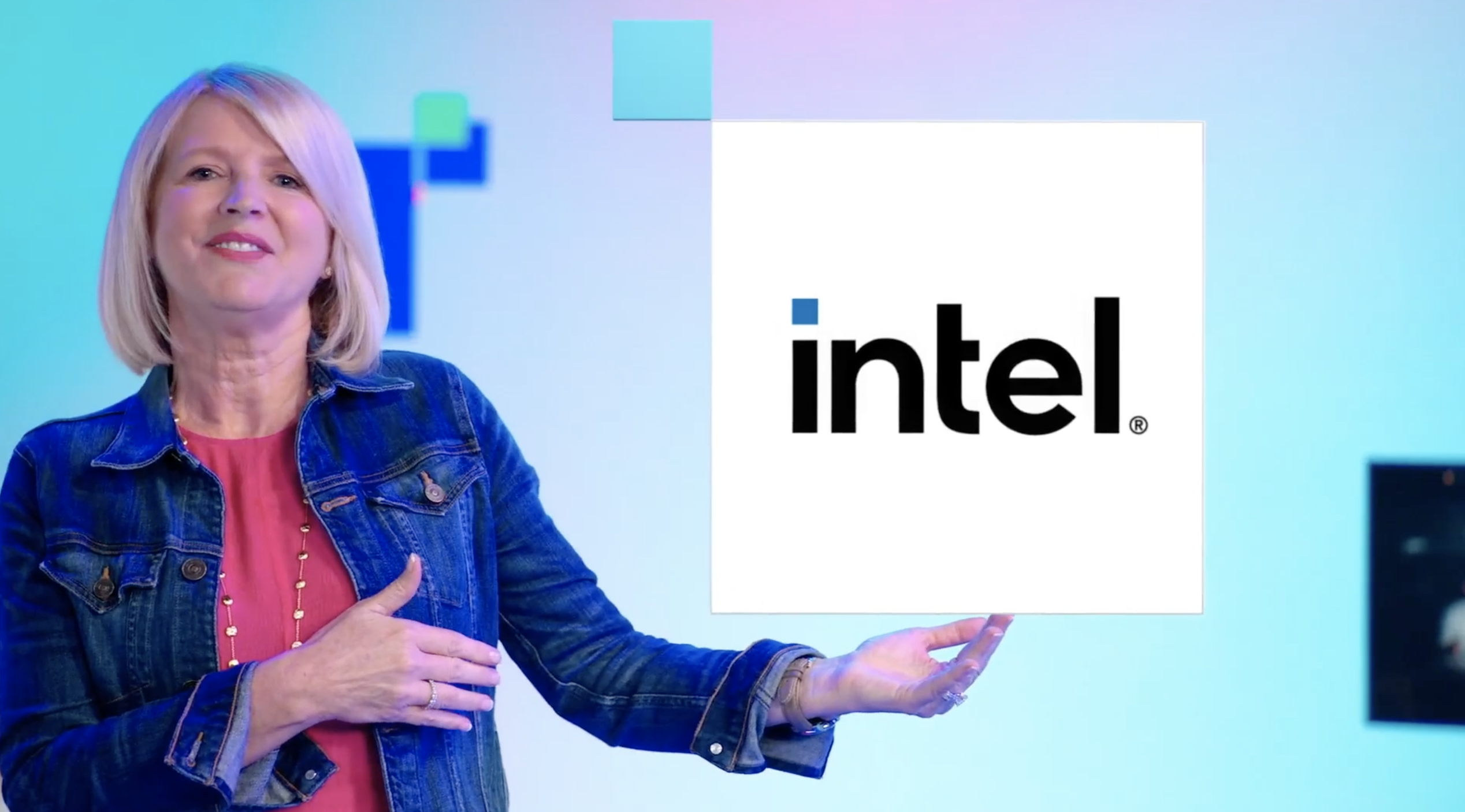

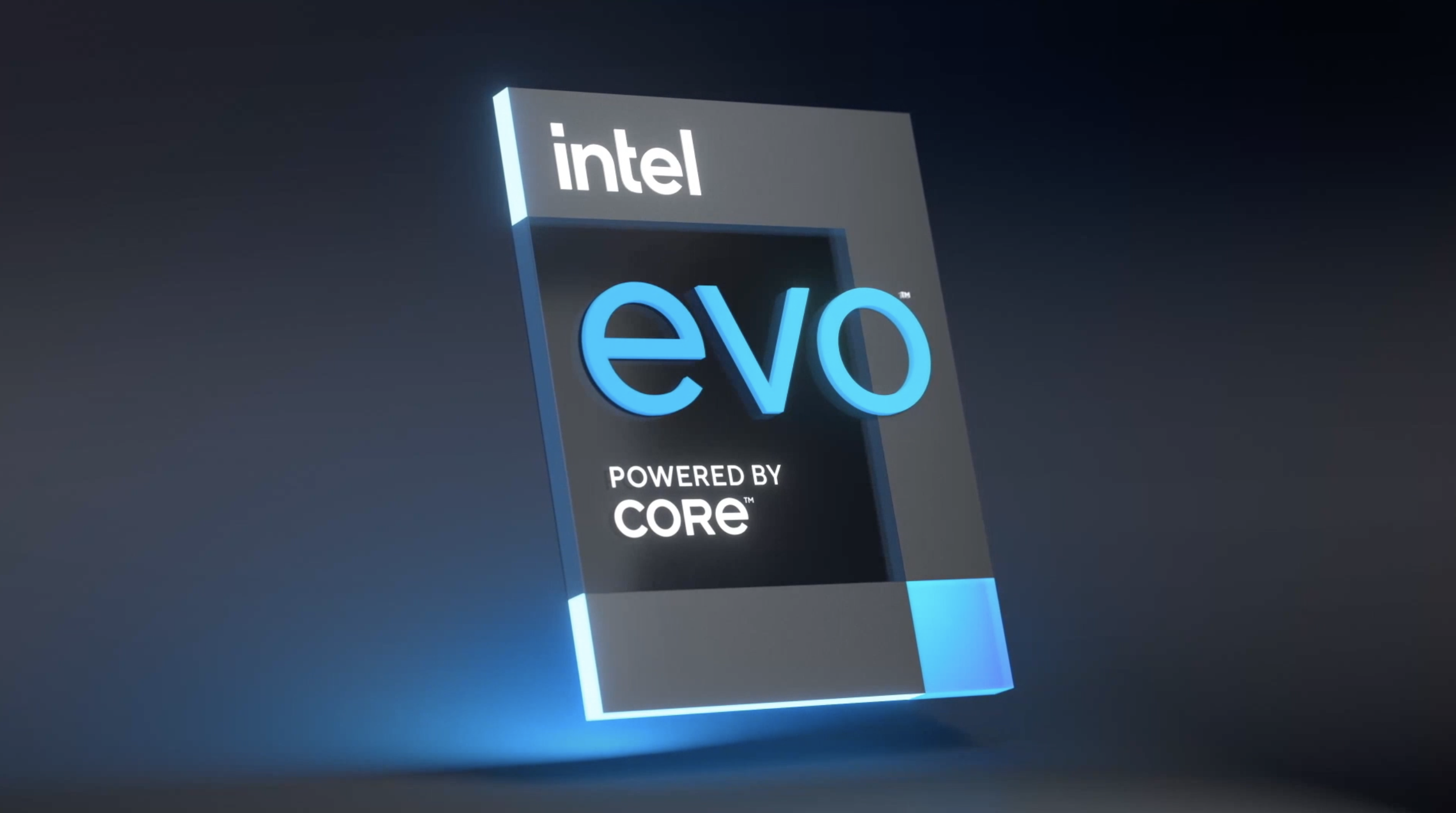
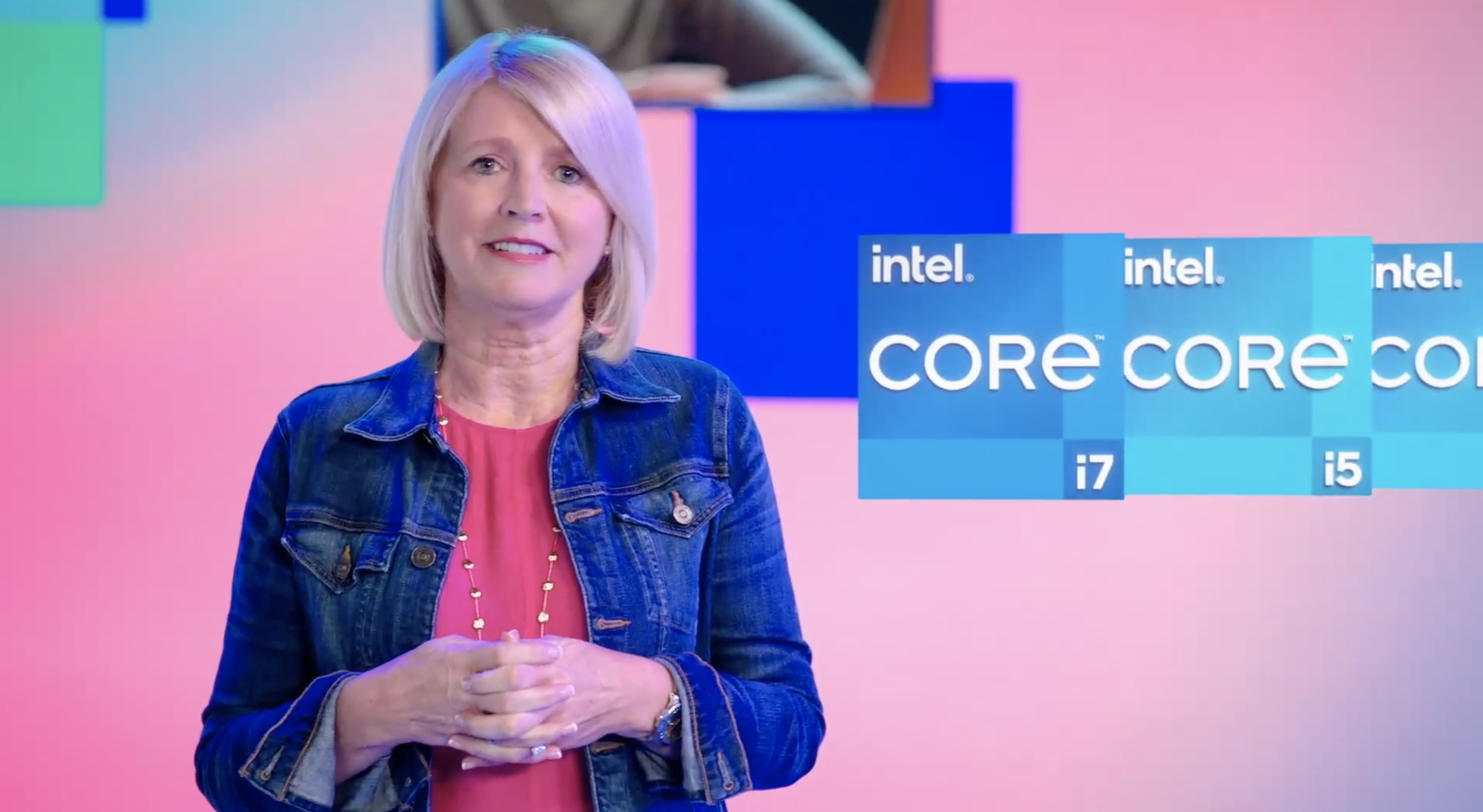
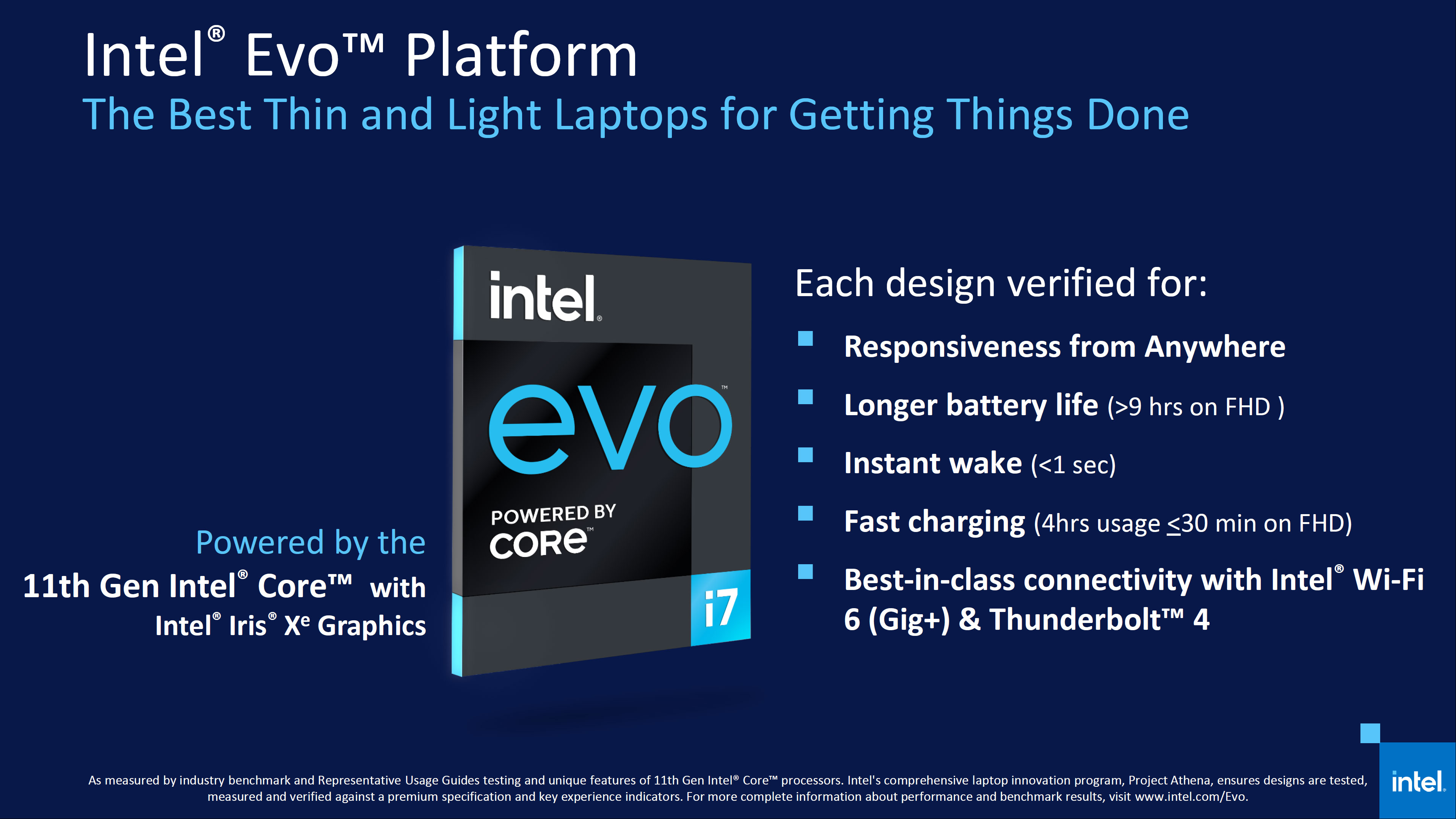
There's a lot to cover and Intel hasn't shared the full details yet, so look for continued updates as we learn more. However, we've finally got some firm specs, so let's get right to the silicon.
Intel 11th-Gen Tiger Lake Core i3, Core i5, Core i7 Specifications
| PROCESSOR NUMBER | CORES/THREADS | GRAPHICS (EUs) | CACHE (MB) | OPERATING RANGE (W) | BASE CLOCK SPEED (GHZ) | MAXIMUM SINGLE CORE TURBO FREQ (GHZ) | MAXIMUM ALL CORE TURBO FREQ (GHZ) | GRAPHICS MAX FREQ (GHZ) | MEMORY SUPPORT |
|---|---|---|---|---|---|---|---|---|---|
| i7-1185G7 | 4C/ 8T | 96 | 12 | 12 - 28 | 3.0 | 4.8 | 4.3 | 1.35 | DDR4-3200, LPDDR4x-4266 |
| i7-1165G7 | 4C/ 8T | 96 | 12 | 12 - 28 | 2.8 | 4.7 | 4.1 | 1.30 | DDR4-3200, LPDDR4x-4266 |
| i5-1135G7 | 4C/ 8T | 80 | 8 | 12 - 28 | 2.4 | 4.2 | 3.8 | 1.30 | DDR4-3200, LPDDR4x-4266 |
| i3-1125G4* | 4C/ 8T | 48 | 8 | 12 - 28 | 2.0 | 3.7 | 3.3 | 1.25 | DDR4-3200, LPDDR4x-3733 |
| i3-1115G4 | 2C/ 4T | 48 | 6 | 12 - 28 | 3.0 | 4.1 | 4.1 | 1.25 | DDR4-3200, LPDDR4x-3733 |
| i7-1160G7 | 4C/ 8T | 96 | 12 | 7 - 15 | 1.2 | 4.4 | 3.6 | 1.10 | LPDDR4x-4266 |
| i5-1130G7 | 4C/ 8T | 80 | 8 | 7 - 15 | 1.1 | 4.0 | 3.4 | 1.10 | LPDDR4x-4266 |
| i3-1120G4* | 4C/ 8T | 48 | 8 | 7 - 15 | 1.1 | 3.5 | 3.0 | 1.10 | LPDDR4x-4266 |
Intel announced nine new Tiger Lake chips that hit the Core i3, Core i5, and Core i7 families. Intel splits these into UP3 (15W, formerly U-Series) and the UP4 (7.5W, formerly Y-Series) families. As with Intel's previous-gen chips, the TDP range is configurable, meaning UP3 chips can span from 12 to 28W while UP4 chips can operate from 7 to 14W. This allows laptop makers to tailor the chips for the thermal capabilities of their products, with high-end models having sufficient cooling to enable full performance, while lower-end models with less-capable cooling can be tuned to a lower TDP setting.
The new 10nm SuperFin iteration of Intel's original (and problematic) 10nm process brings several new breakthroughs that Intel says boosts performance as much as we would normally see from a transition to a new, denser process node.
The first wave of chips spans from dual-core quad-thread models to quad-core eight-thread models, with the Core i7-1185G7 slotting in as the flagship model. This model comes with the Xe LP graphics engine with the full complement of 96 EUs, so Intel brands it as Iris Xe. The graphics unit runs at 1.35GHz, an increase of 250 MHz over the previous-gen graphics on the Core i7-1068NG7. Paired with Gen12's improved IPC performance, Intel says this provides up to twice the performance and improved power efficiency compared to the previous Gen11 graphics. The chip comes armed with 12MB of L3 cache and supports LPDDR4X-4266.
The Tiger Lake chips come with Willow Cove cores paired with the new 10nm SuperFin process, with the combination powering up to a 20% frequency improvement. The Core i7-1185G7 boosts to 4.8 GHz and has a 3.0 GHz base, both of which are a big increase of 700 MHz over the previous gen models. We see similar specs play out throughout the product stack, with increased core and graphics clocks over the previous-gen models.
The maximum all-core frequencies, in particular, are impressive. How long the chips can sustain these all-core boosts is another question entirely and will vary based upon thermal and power considerations.
Get Tom's Hardware's best news and in-depth reviews, straight to your inbox.
The Tiger Lake chips come with Willow Cove cores paired with either the new integrated Xe LP graphics engine, the low-powered variant of the Gen12 architecture, with Iris Xe units that come with 96EUs. That's an increase of 32 EUs (execution units) over the previous-gen graphics. Intel paints its Tiger Lake canvas on its new 10nm SuperFin canvas (deep dive here). Intel splits its graphics capabilities up into G7 models with 96 or 80 EUs, and G4 models with 48 EUs.
You'll also notice that two of the Core i3 models, the i3-1125G4 andi3-1115G4, only support up to LPDDR4-3773, while the other models reach up to LPDDR4-4266.
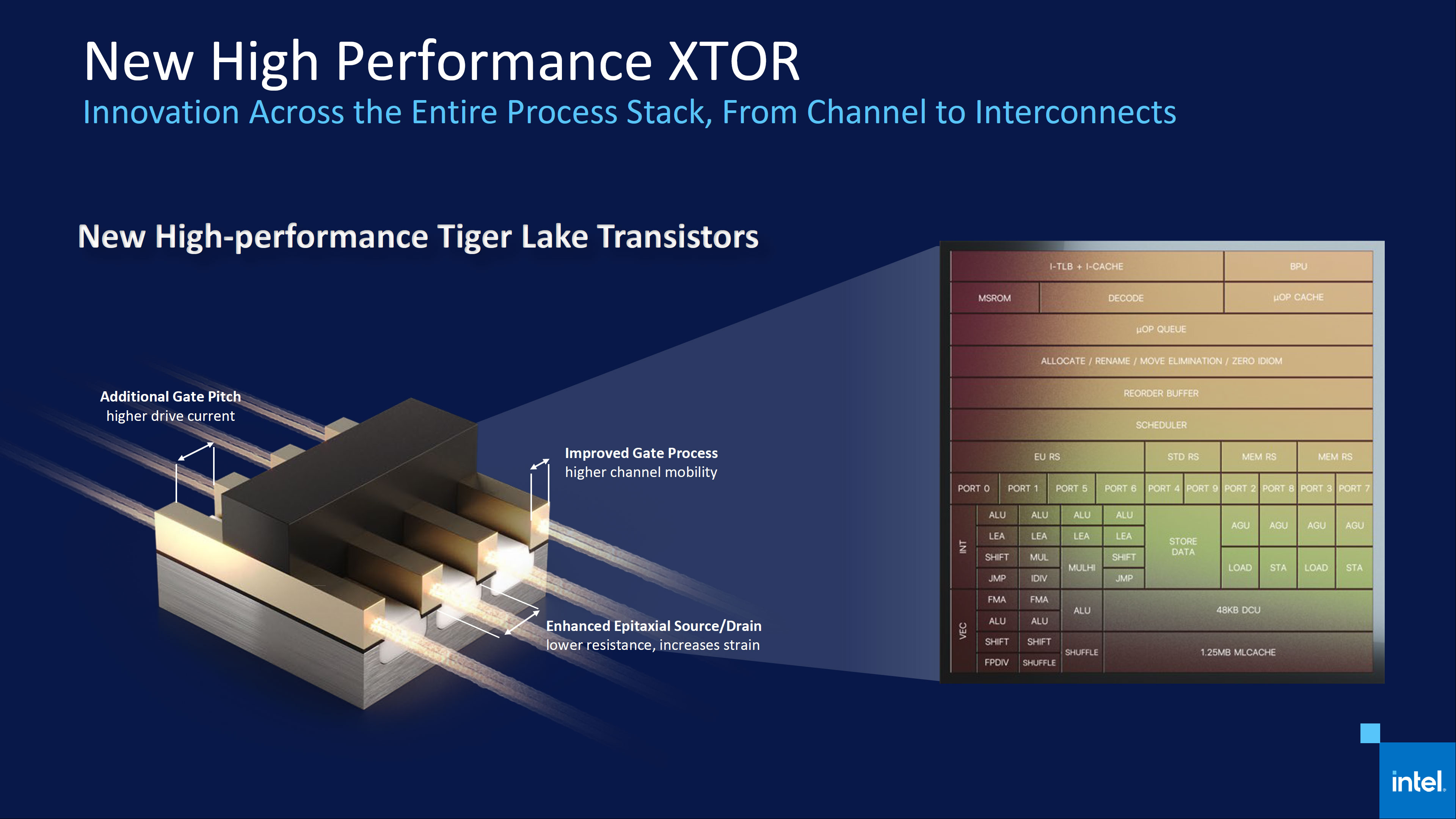
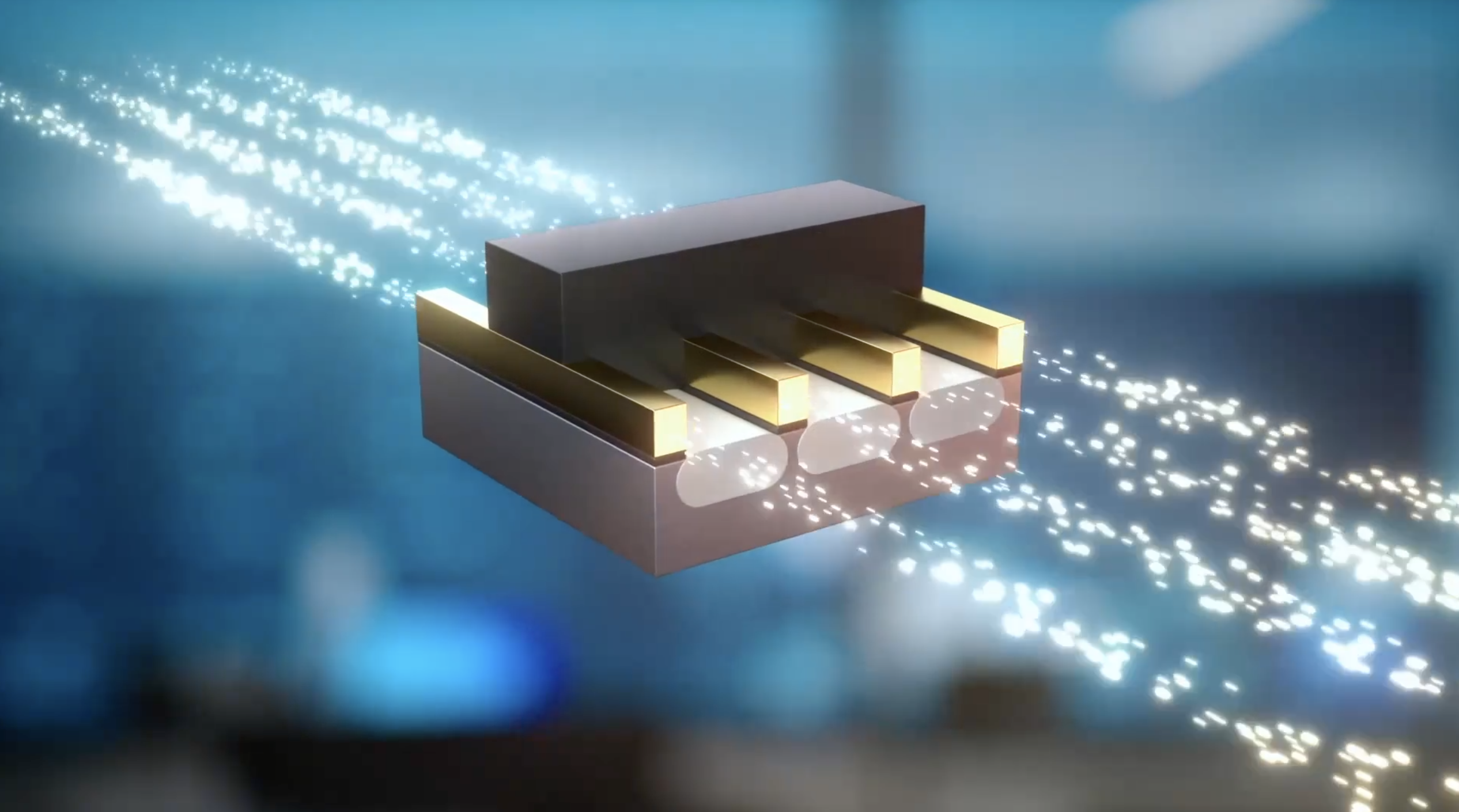



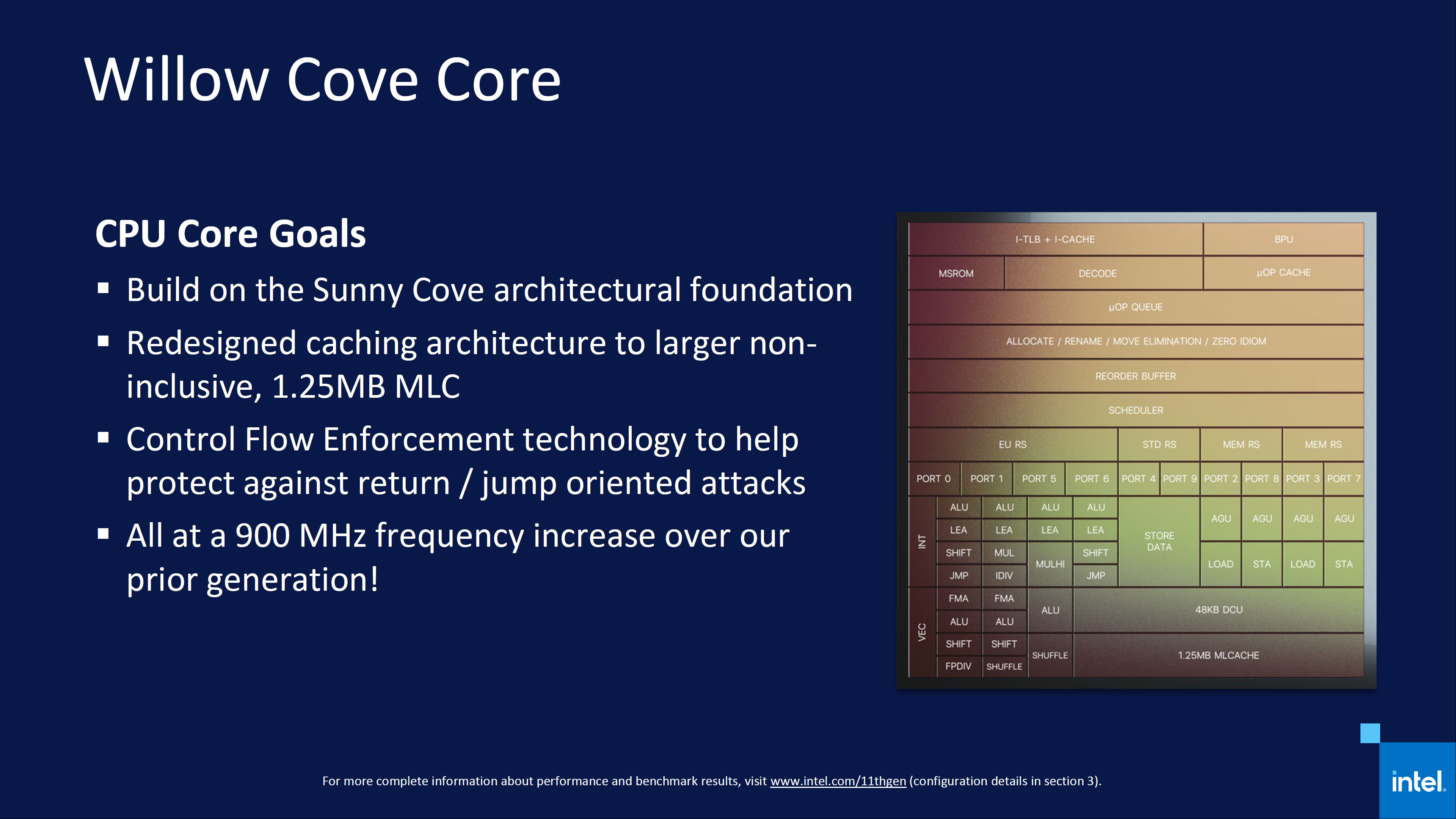
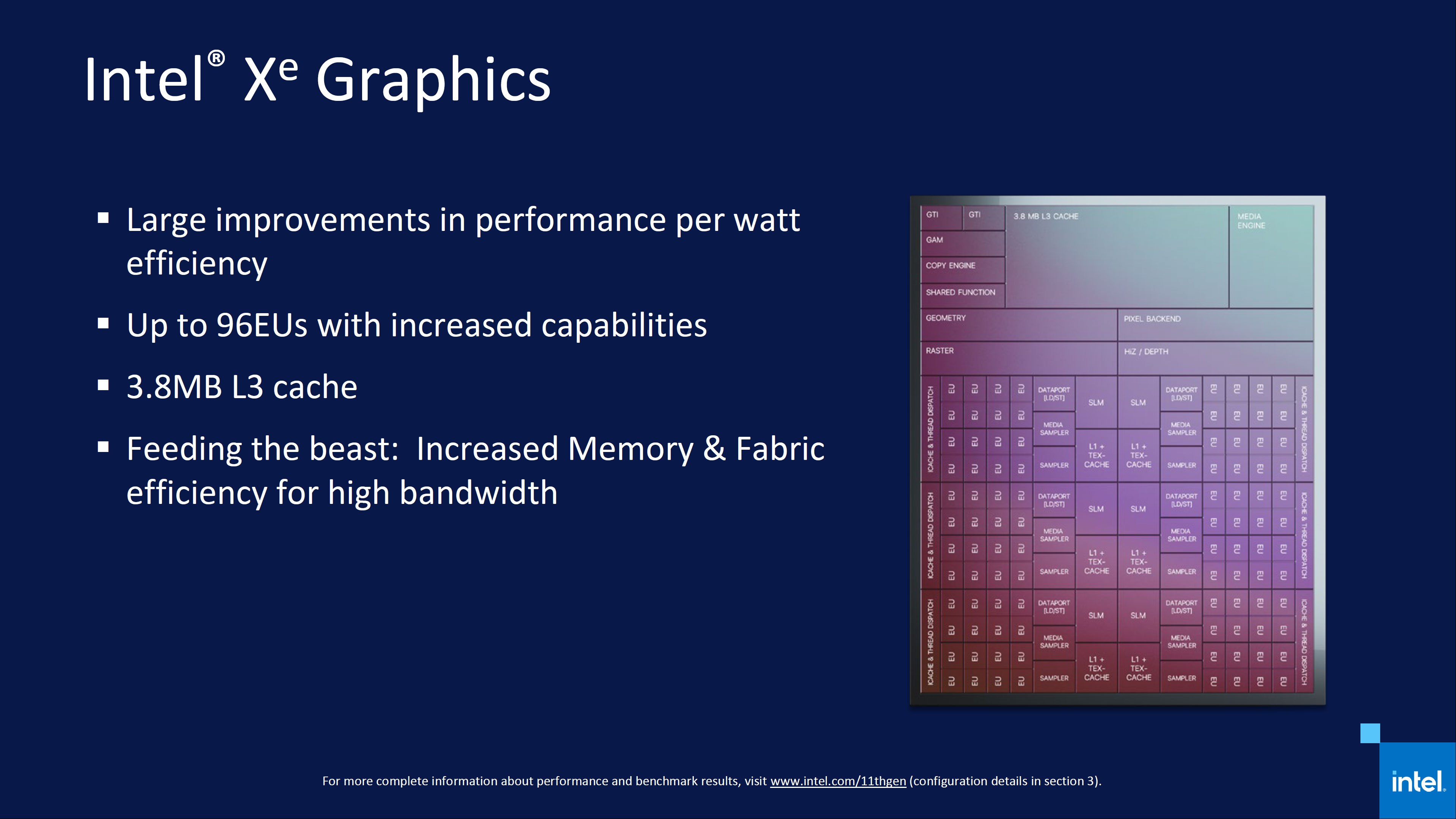
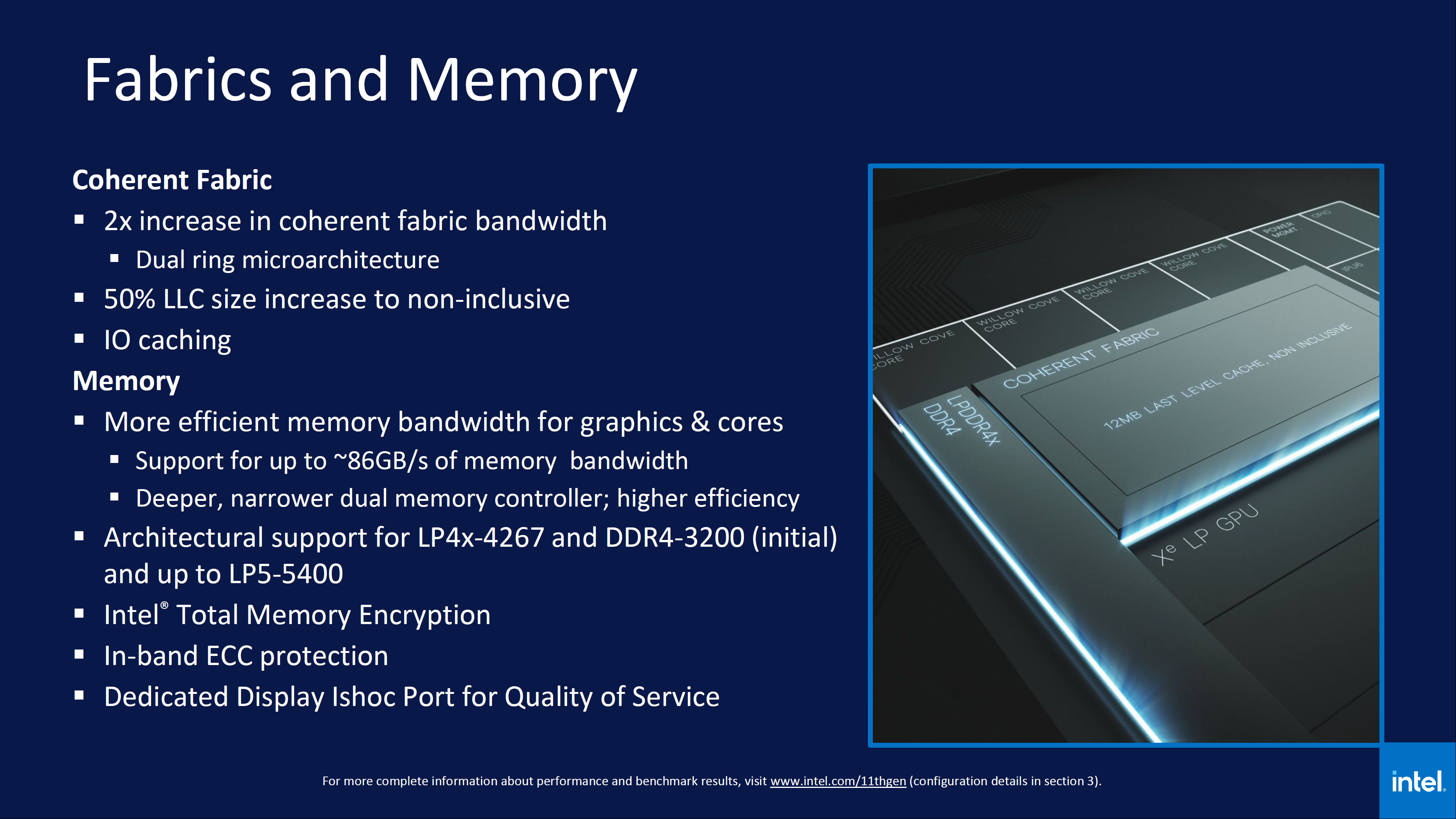

Some of Tiger Lake's biggest gains come from increasing the frequency of the chip. Intel's previous-gen 10nm Ice Lake chips suffered from much lower clock frequencies than their 14nm counterparts, leading to a split product stack with Ice Lake used for gaming systems and the 14nm Comet Lake chips positioned for productivity workloads. Intel says that all of its future mobile chips will use the 10nm SuperFin process, so that situation appears to be rectified.
Intel's 10nm SuperFin transistors address the frequency gap with much higher clock speeds at any given voltage, and they can also operate at a lower voltage at any given frequency, too. As a result, the chip has a greater dynamic frequency range from the minimum to maximum voltage, which provides better performance at every level of performance. That equates to faster mid-range performance in thin-and-light devices, not to mention peak performance in high-performance designs. We have the full details here.
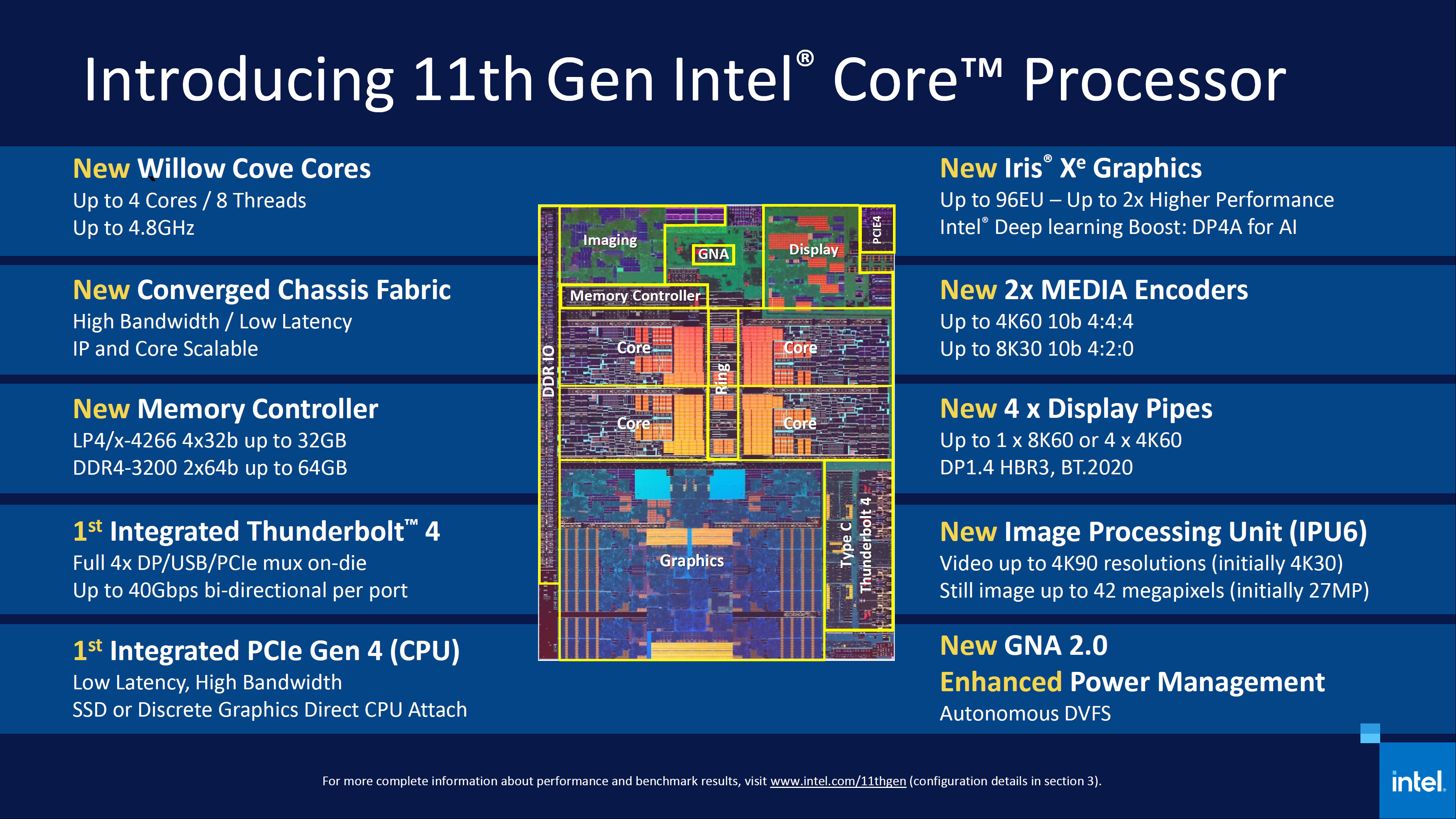
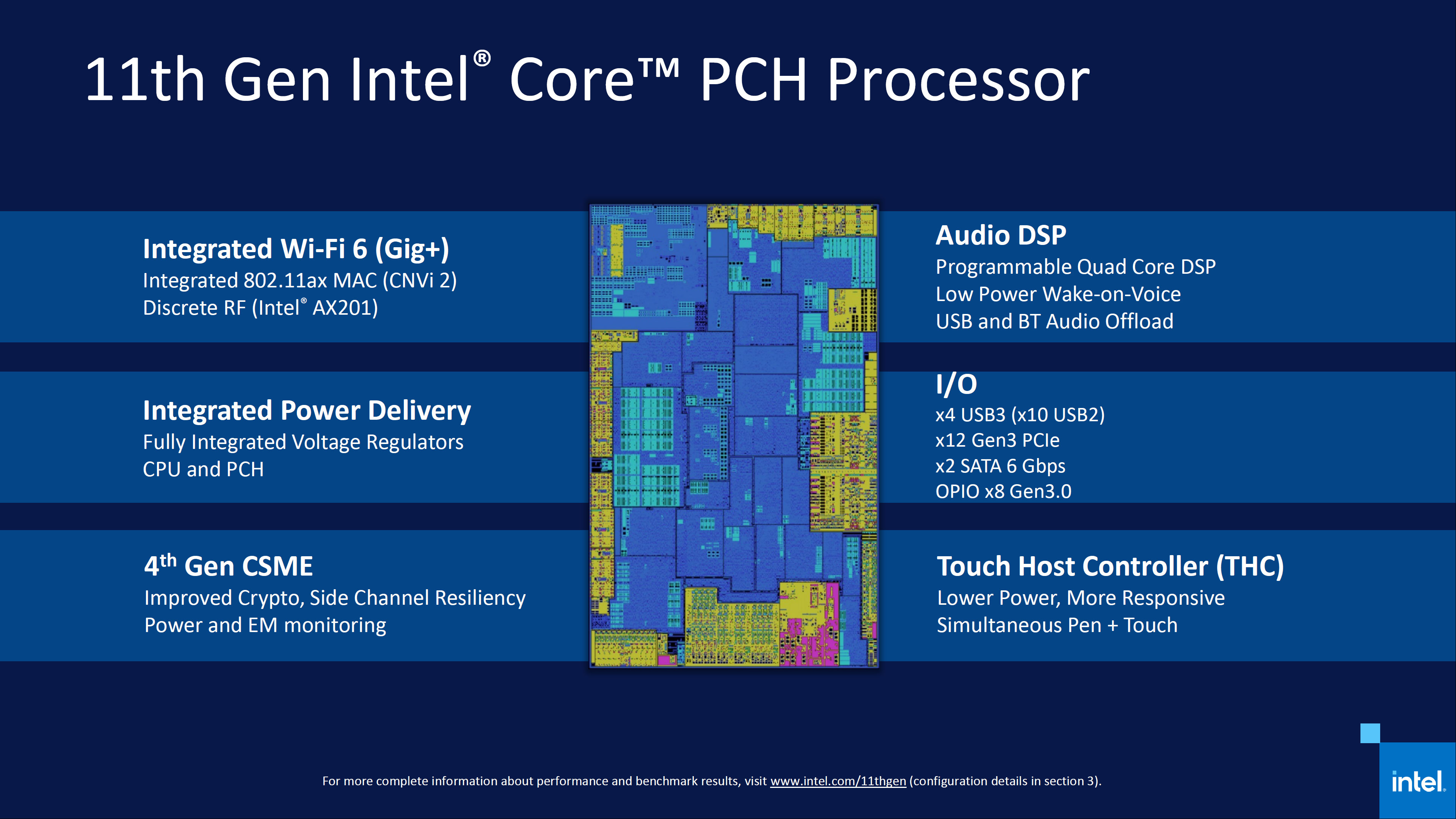
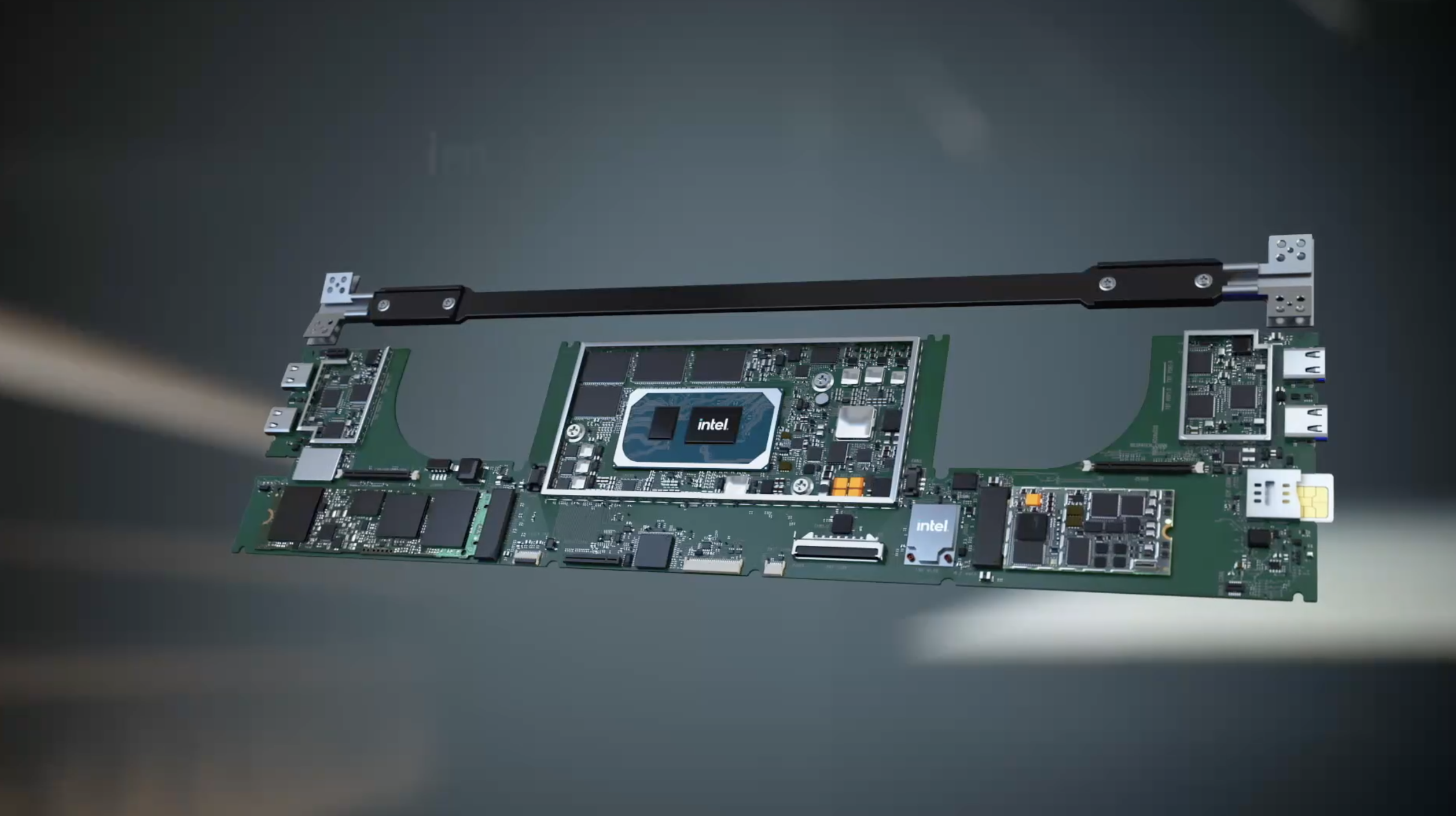
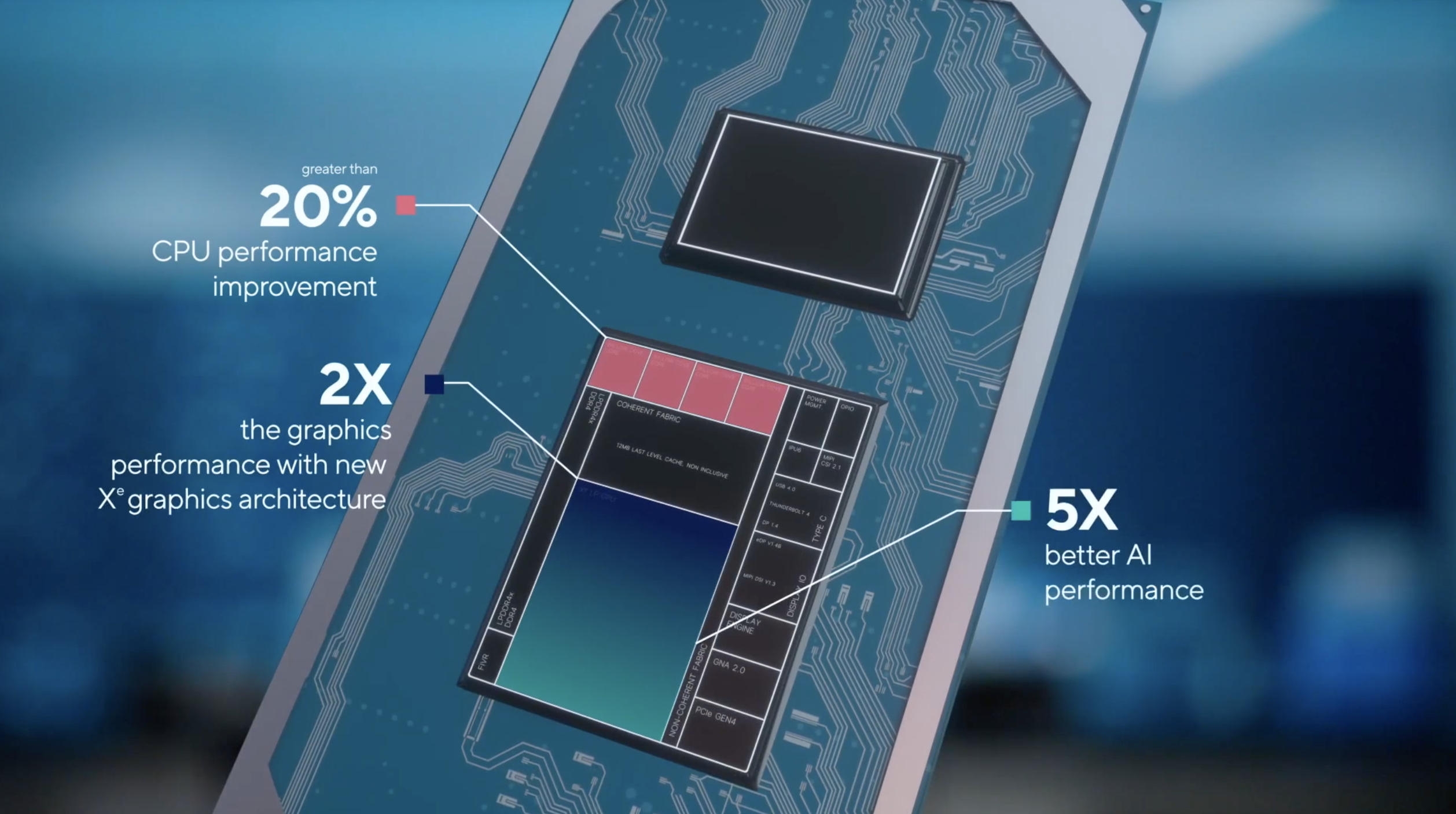
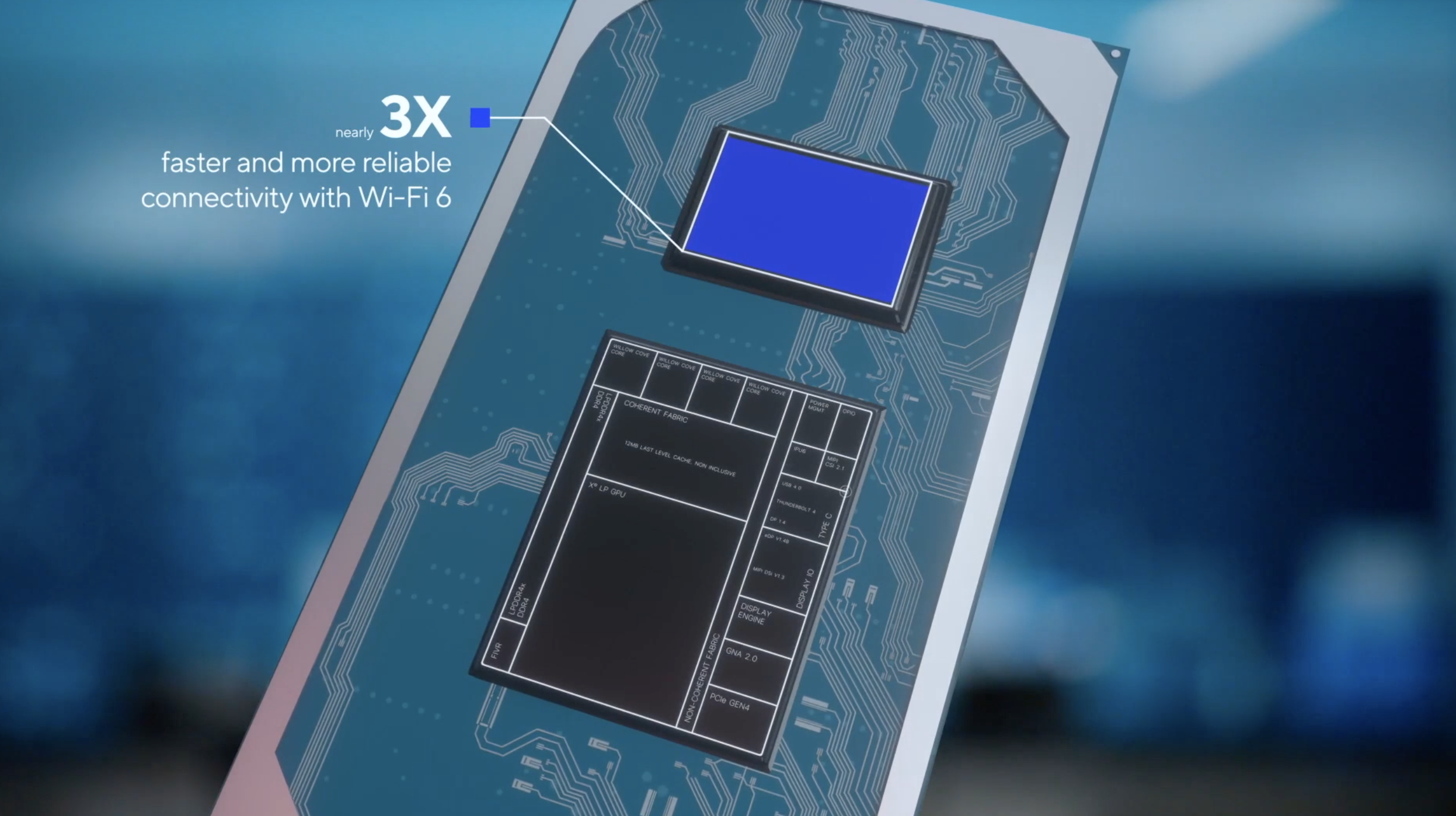


After losing the glory of being the first to PCIe 4.0 on the desktop (AMD holds that distinction), Intel is the first to bring PCIe 4.0 support to laptops. The faster interface enables speedier SSD options that provide more performance and efficiency than their PCIe 3.0 counterparts. Now, the faster PCIe 4.0 interface does draw more power than 3.0, but it can transfer data at up to twice the speed per lane. That helps with reducing the amount of time the interface is active (the proverbial 'race to idle'). Intel added the ability to shut off or dynamically adjust Tiger Lake's PCIe interface when it isn't fully active, and the faster interface could be used to employ fewer lanes during some workloads, both of which will help defray the increased power consumption.
Tiger Lake also comes with baked-in support for LPDDR5-5400 in the future, but the first chips support LPDDR4-4267 for now. That leads to up to ~86 GBps of memory bandwidth, a doubling over Ice Lake's throughput. That will come in handy to feed the Xe graphics engine.
Intel touts its 'new' support for integrated Thunderbolt 4 and USB 4, but these aren't really 'new' protocols. In short, with speeds up to 40Gb/s, Thunderbolt 4 maintains the same maximum speed rating as its predecessor (TB3) and doesn't enable new features. Instead, in order to qualify for certification, vendors must enable all of the high-end features that used to be optional, like the ability to hit the 40Gb/s data throughput requirements and support two 4K displays or one 8K display. This approach does simplify the confusing branding surrounding Thunderbolt 3, but from a hardware standpoint, the speeds and feeds remain the same.
Intel Tiger Lake Iris Xe Graphics Gaming Performance
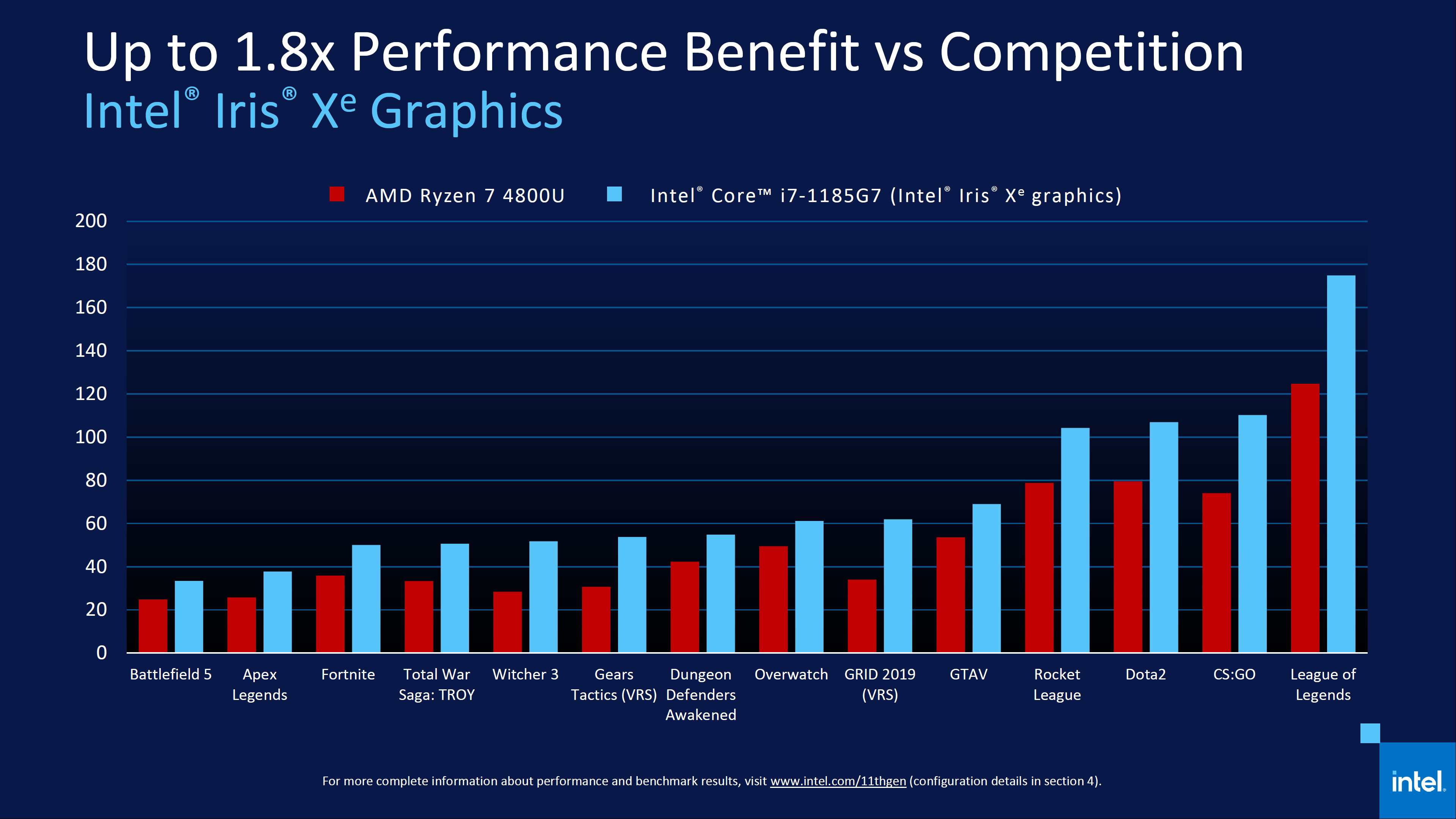
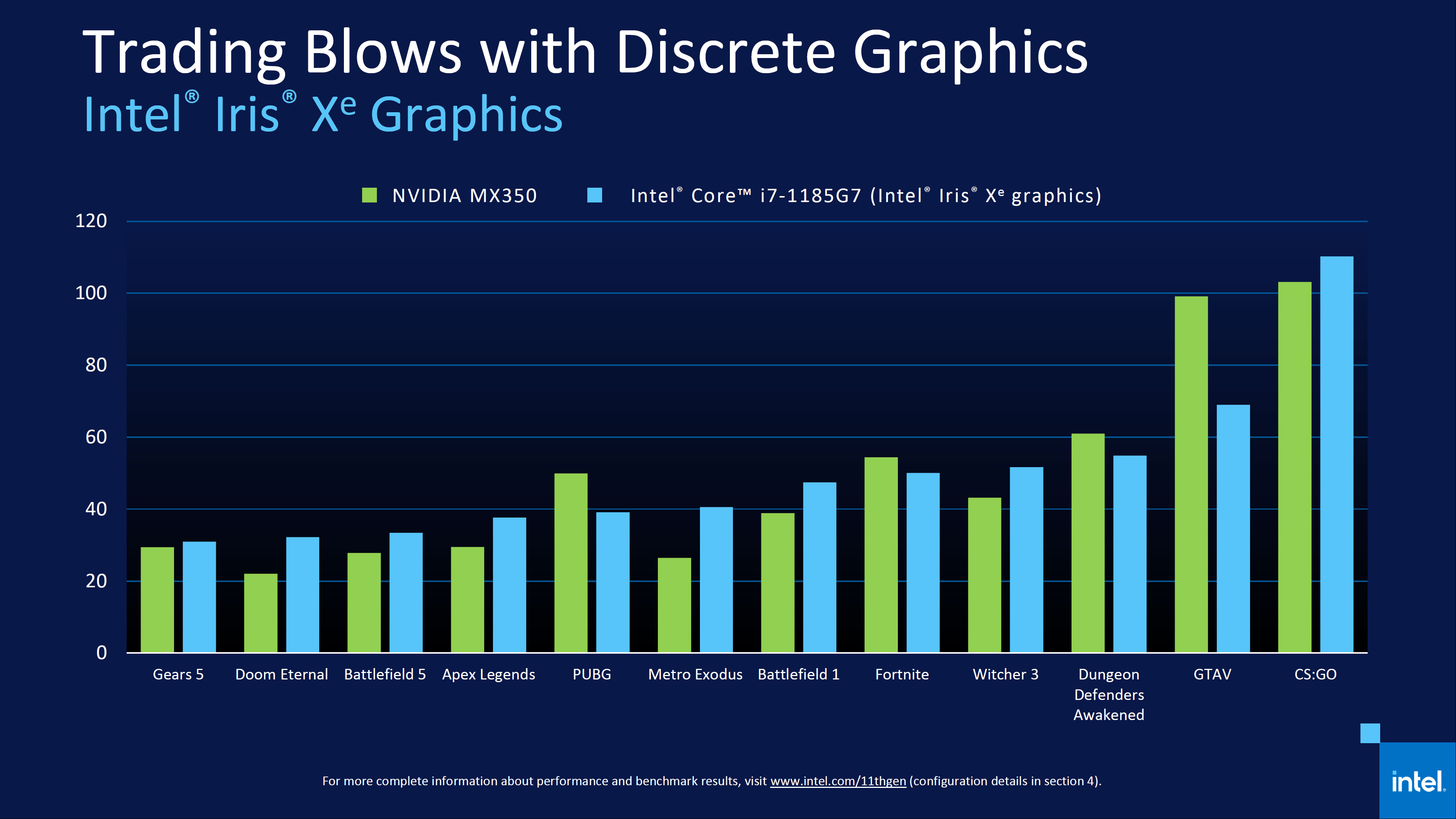
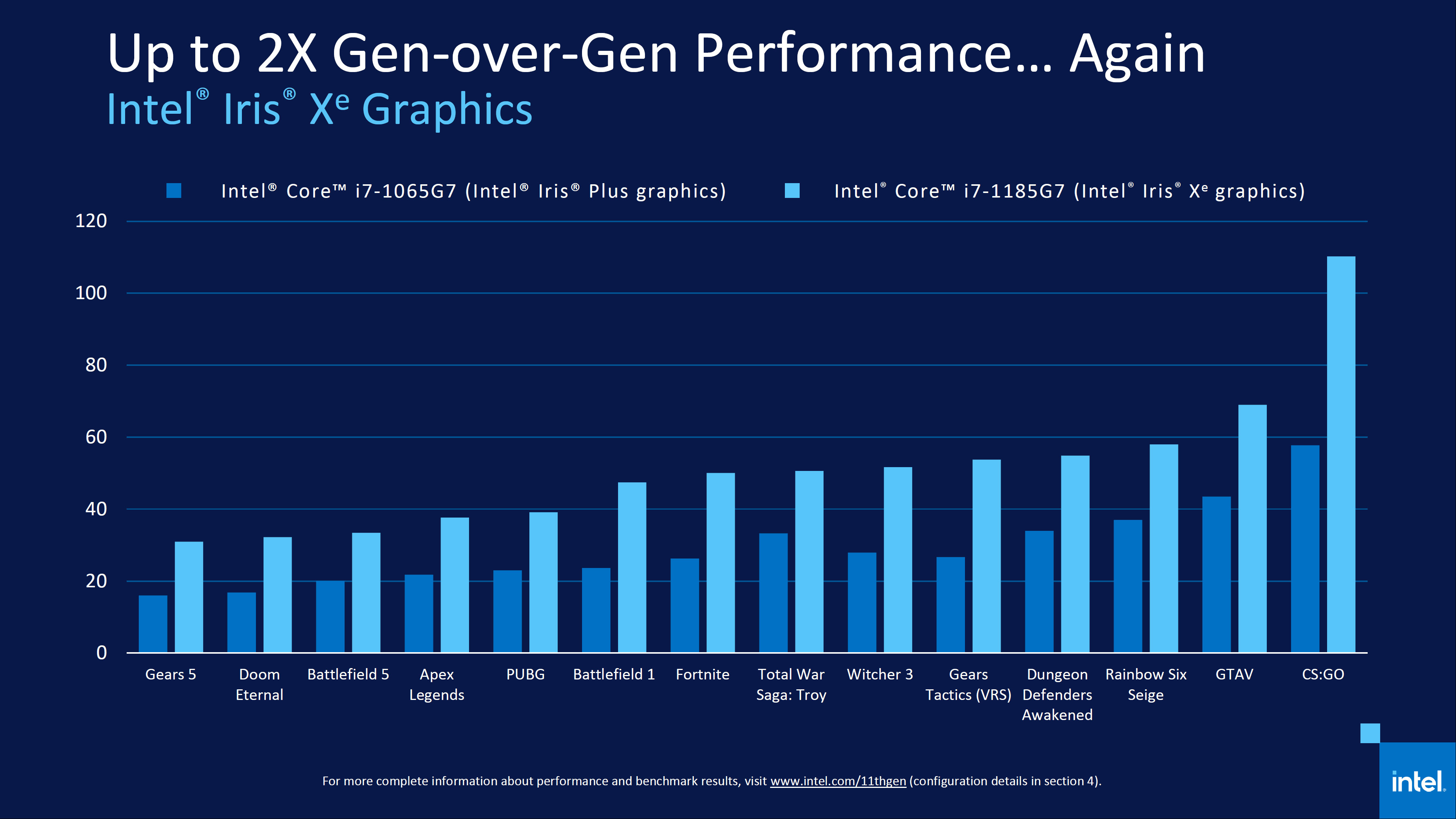
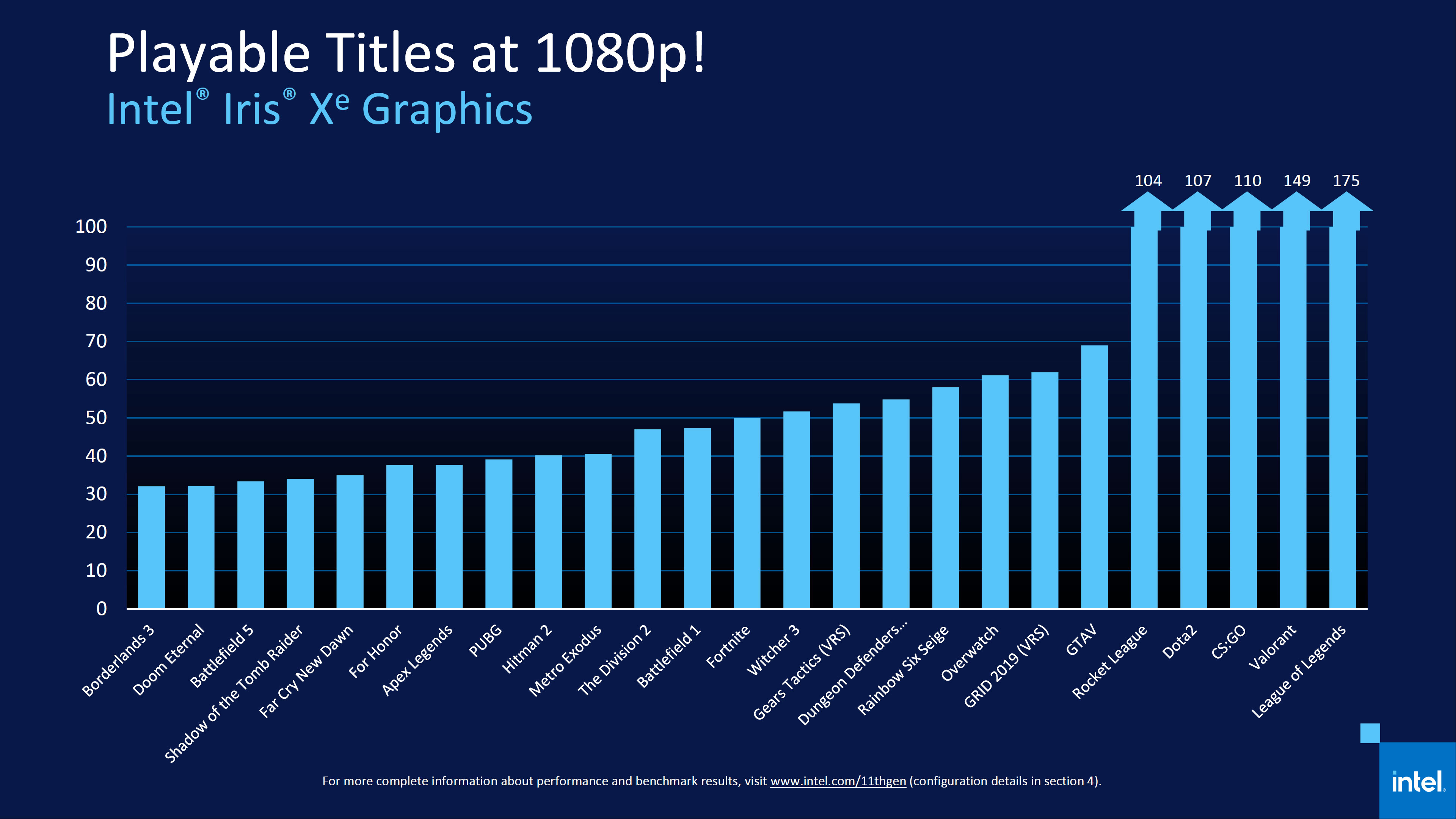
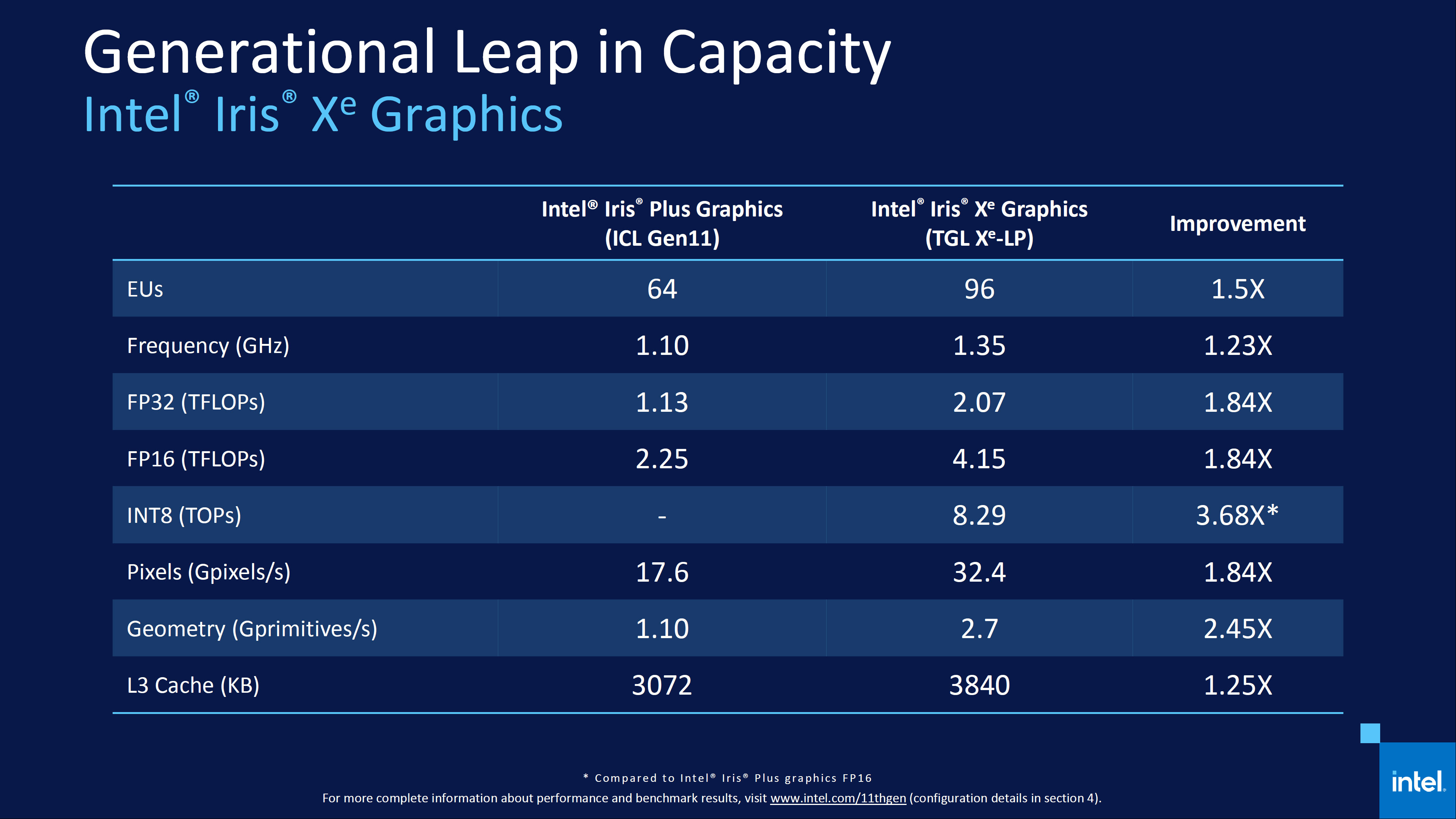
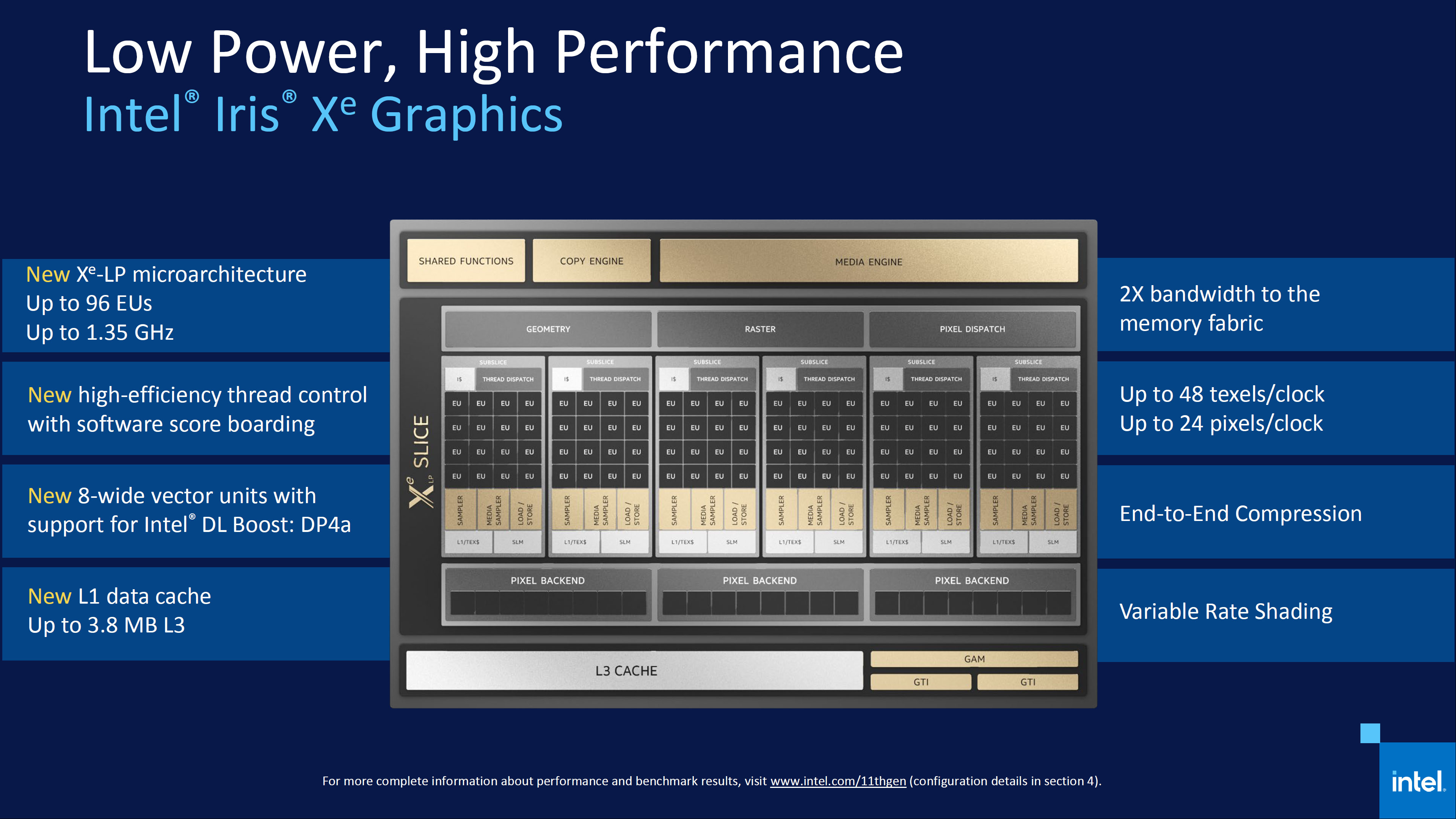
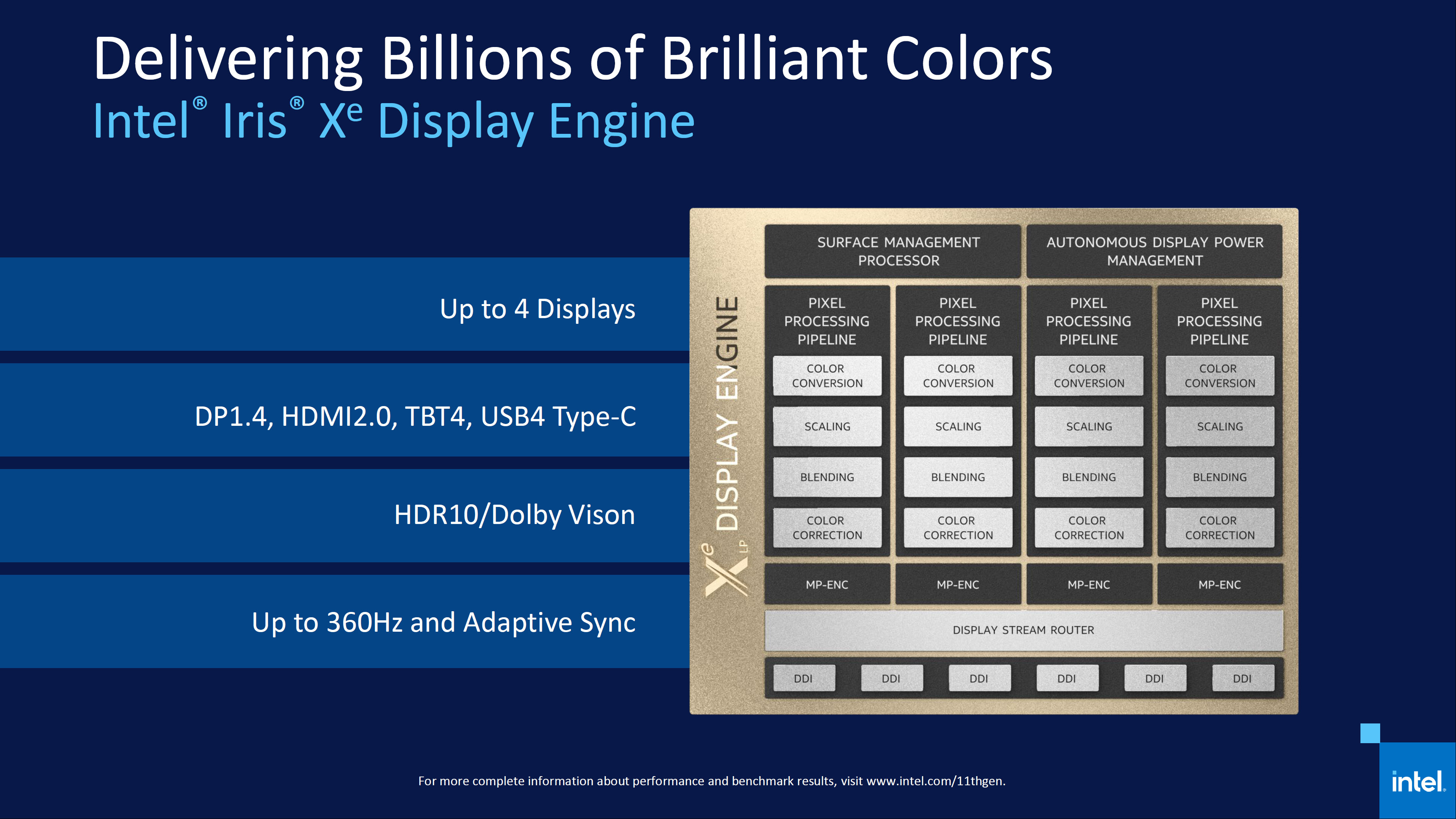
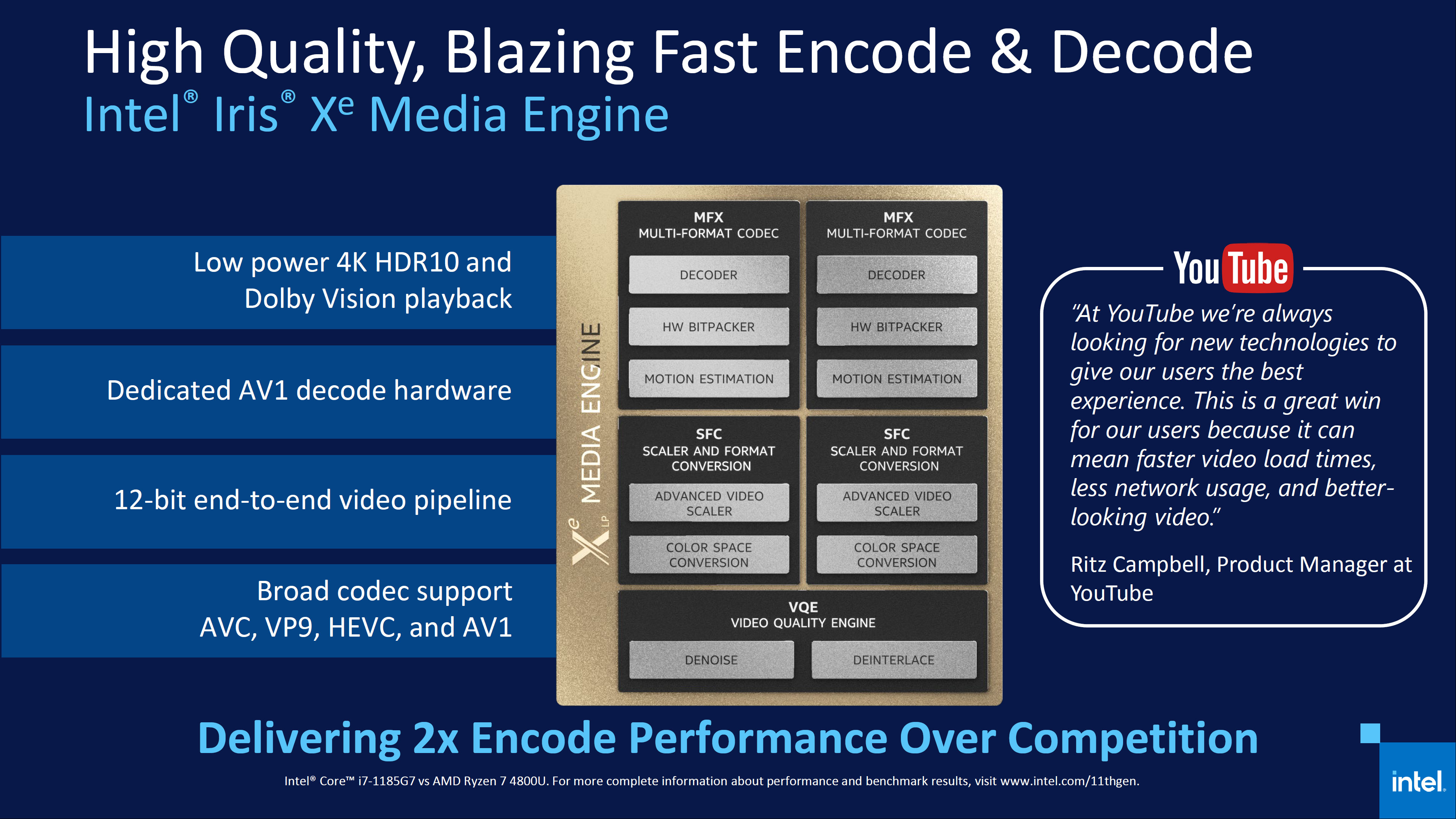
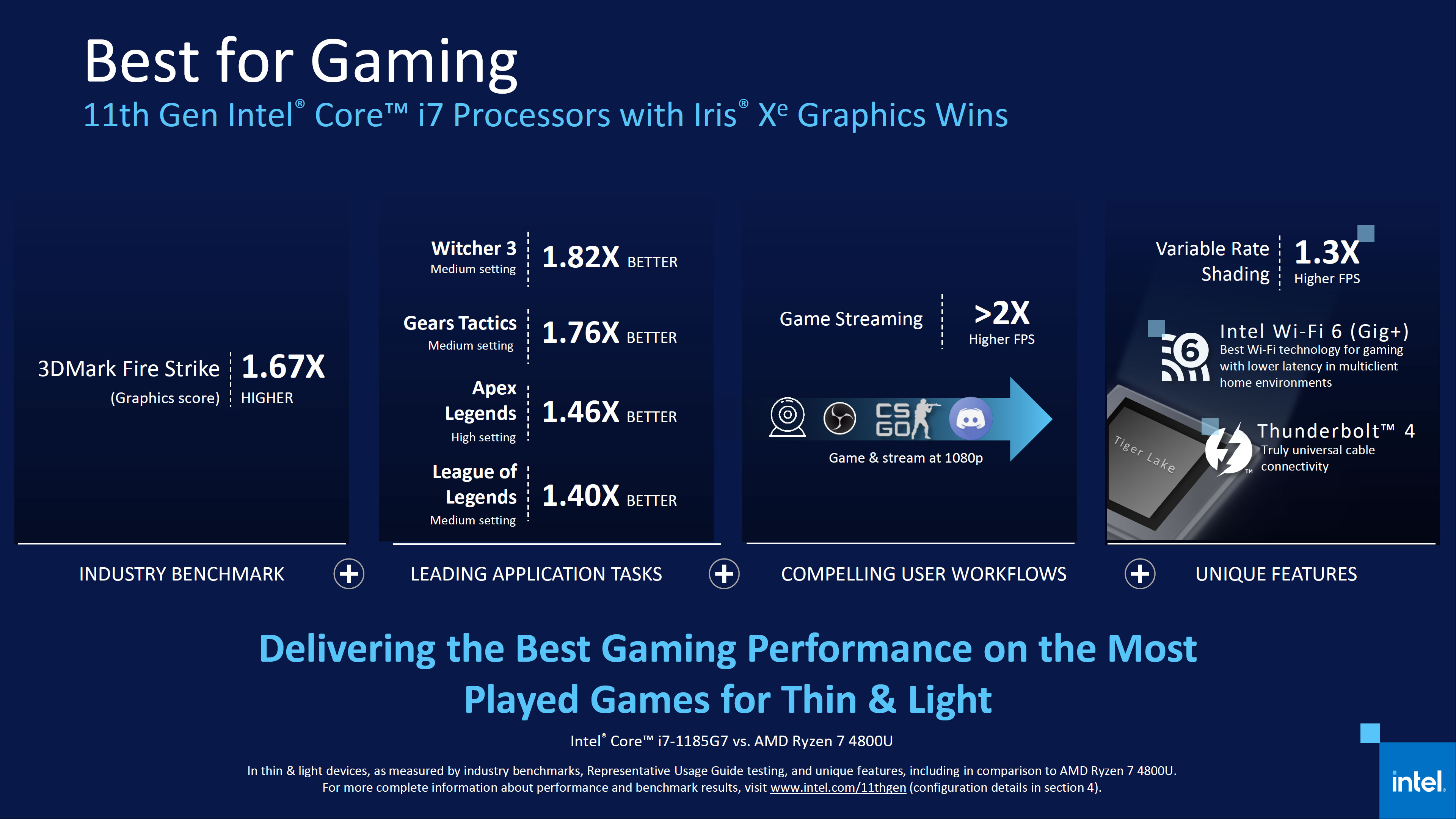

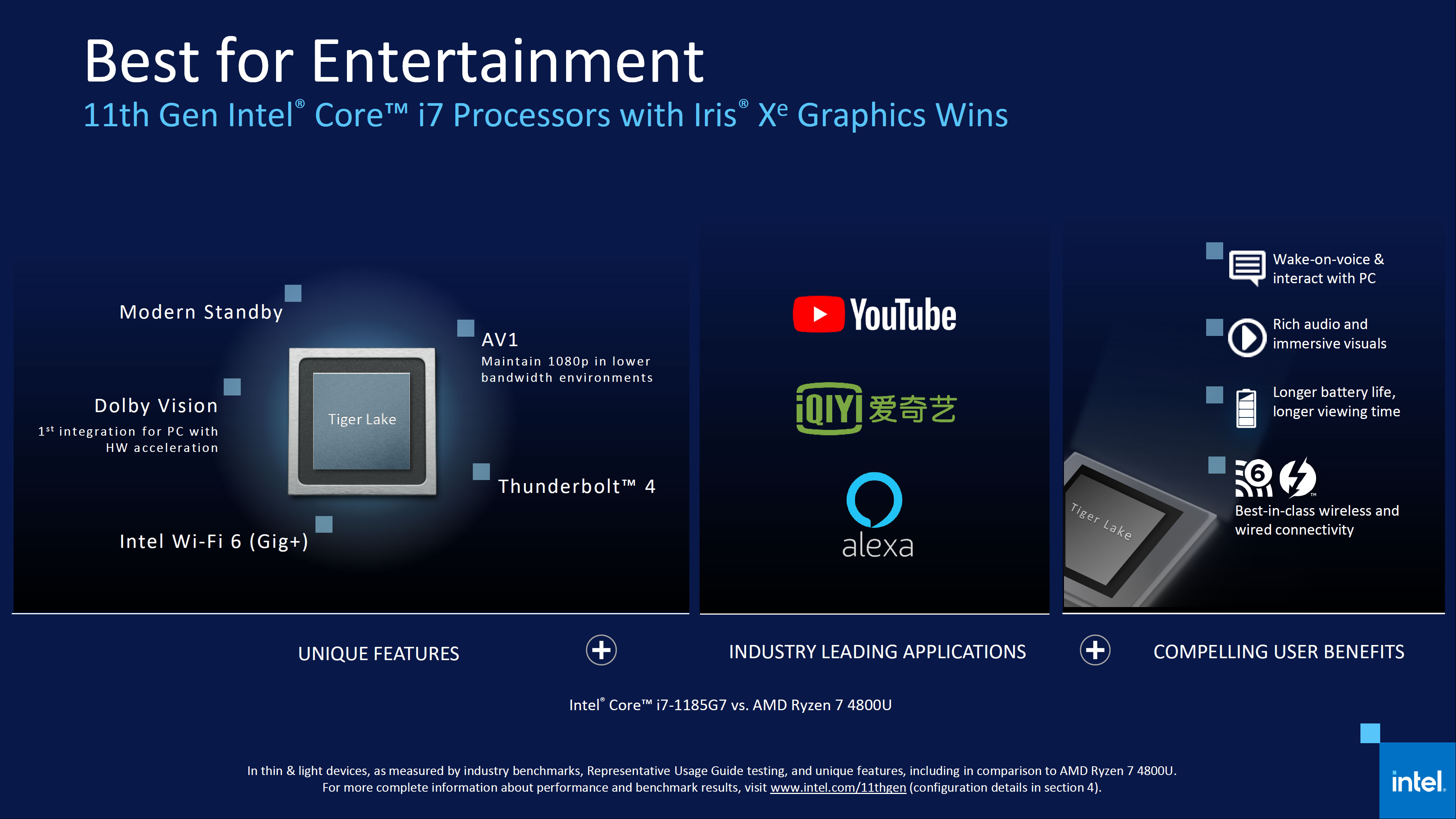
We covered the deep dive details of Intel's Xe LP graphics here, so now it's time to see the new Iris Xe integrated graphics in action. Intel shared plenty of its own results, but as with all vendor-provided benchmarks, take these with a grain of salt.
Intel claims it's Xe graphics outperforms AMD's Ryzen 7 4800U by up to 1.8X in a range of titles, and that it can even tackle Nvidia's discrete MX350 in 1080p gaming. Compared to the previous-gen Core i7-1065G, Intel says the Core i7-1185G7 offers a neat doubling of performance. Of course, these performance figures outline the highest-performance configuration, so performance with fewer EUs and/or tighter thermal constraints (like in thin-and-light devices) will result in lower performance.
Intel revamped its display engine, too. We're looking at hardware acceleration for AV1 decode, up to four display pipelines, 8K UHD and Ultra Wide, 12-bit BT2020 color, and 360Hz and Adaptive Sync, among others listed in the album above. Tiger Lake also supports up to six 4K90 sensors (support starts at 4K30) and can process still images up to 42 megapixels, an increase over the prior 27MP limitation with Ice Lake.
Intel Tiger Lake AI and AVX Performance

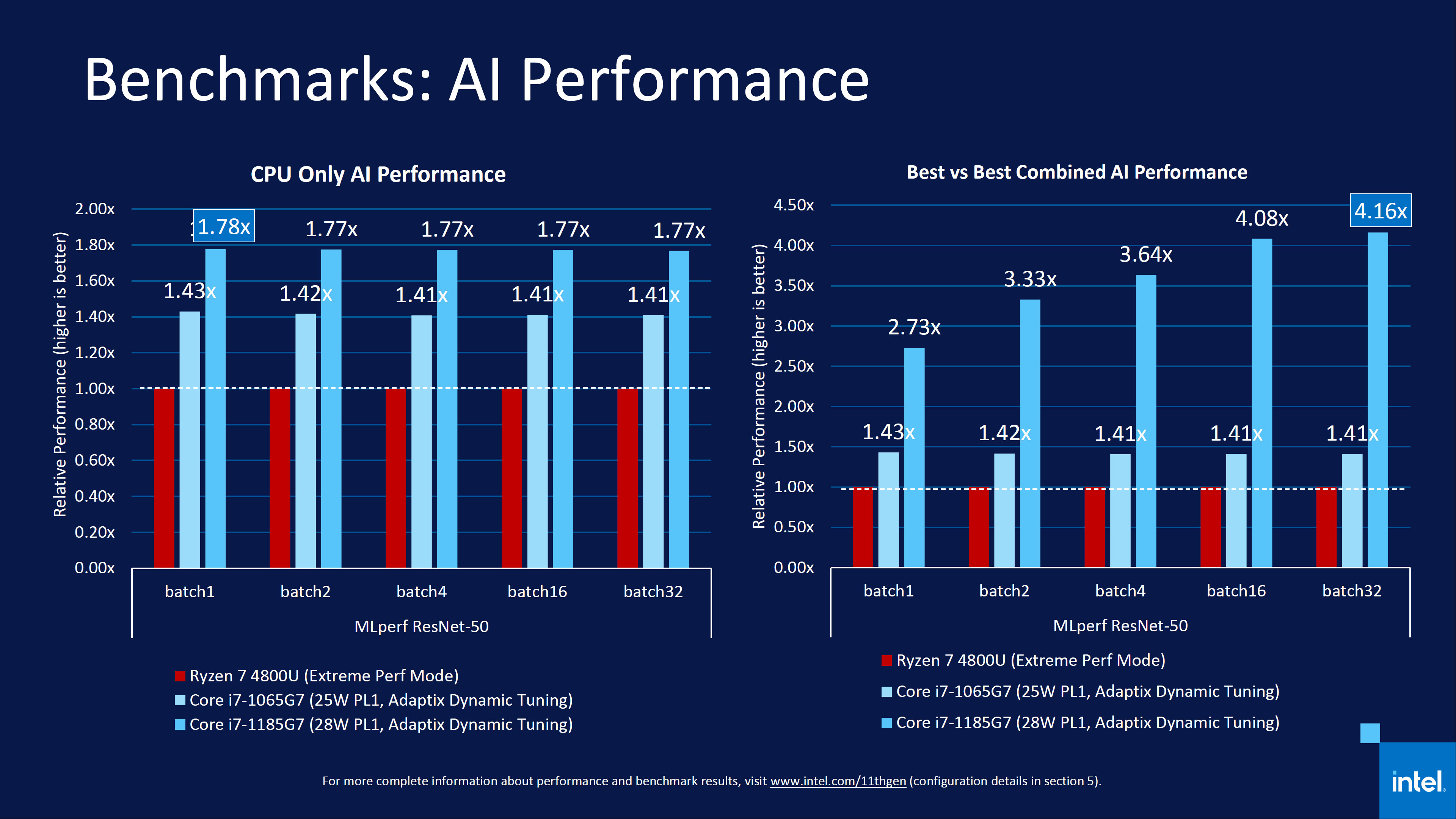
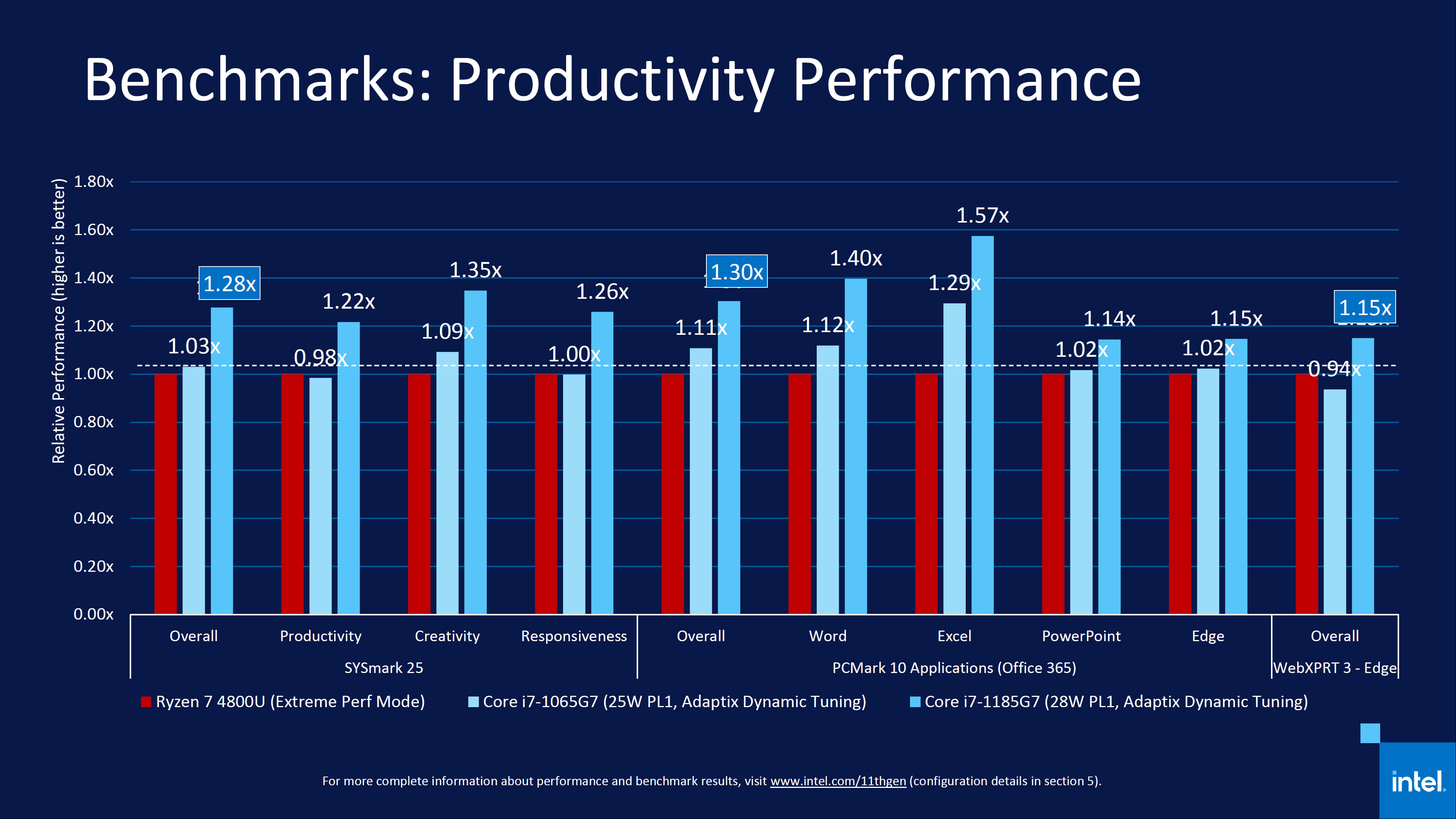







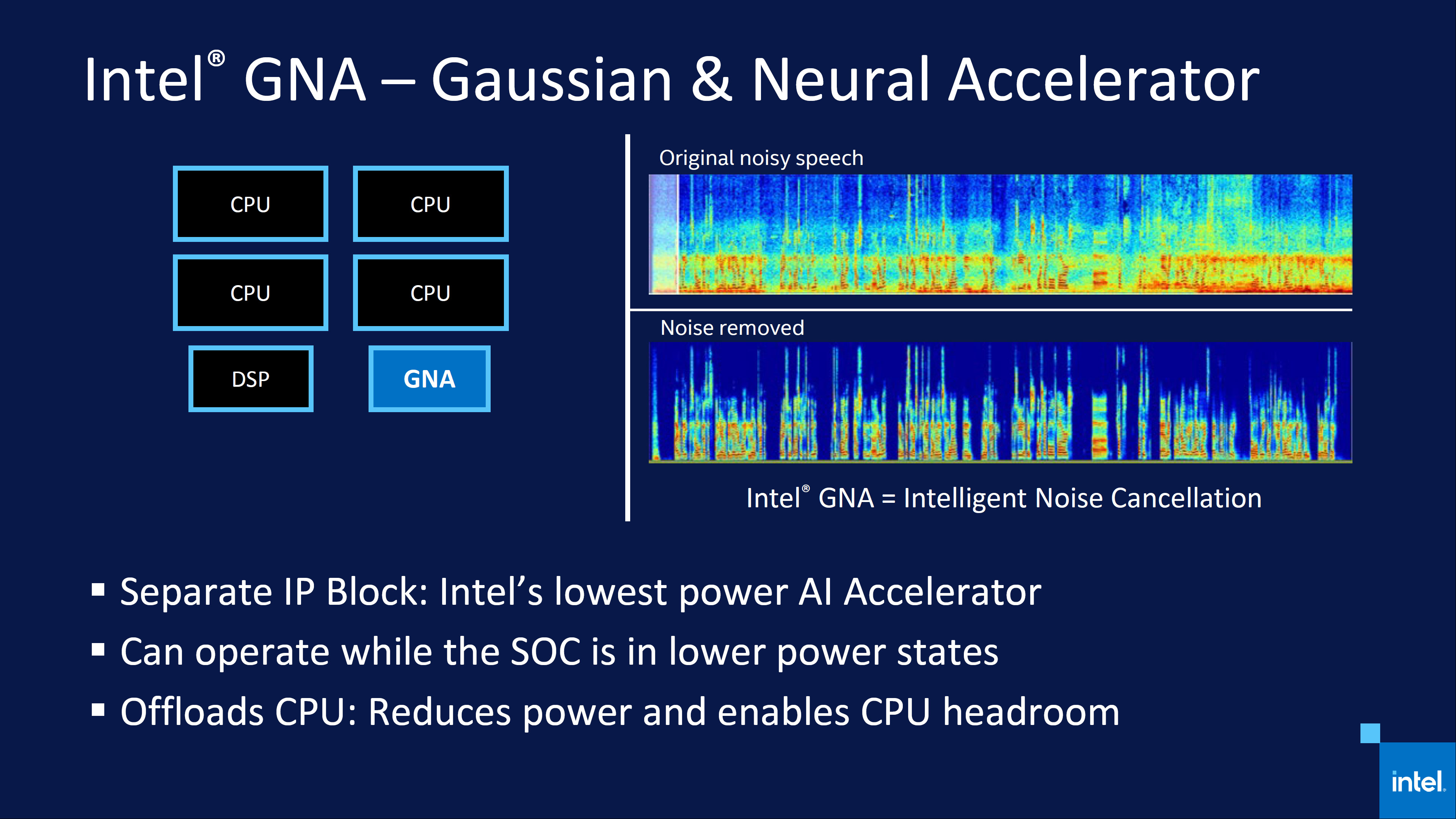
Intel is also making a big push into AI capabilities as it works with a slew of software vendors to enable support for its newest capabilities. As with all vendor-provided benchmarks, take the Intel-provided benchmarks above with a grain of salt.
These new software packages yield massive improvements, up to 5X, in performance due to support for AI-boosting VNNI instructions (aka DL Boost - INT8/INT16) that leverage AVX-512 to boost the performance of convolutional neural networks.
Leveraging the AVX instruction set for AI workloads could evolve into a significant advantage over AMD's Ryzen 4000 processors as Intel's software support broadens. Intel's chips have long dropped into lower frequencies as densely-packed AVX instructions work their way through the processor, but Intel has reduced the impact with the SuperMIM capacitor. This capacitor combats vDroop, which helps allow the processor to remain in higher frequency ranges during heavy AVX workloads.
The Gaussian and Neural Accelerator (GNA) returns, but this time with a new 2.0 revision. This SoC-integrated AI accelerator block is used for processing all sorts of low-power voice-based applications, like translation and transcription, using low-power inferencing. Intel claims that this offload engine can reduce CPU utilization by 20% during these types of operations, but at a much lower power consumption of 1 gigaop-per-mW, with a max of 38 gigaops of performance. This unit can be also be used for impressive noise cancelation capabilities without taxing the Willow Cove cores.
Intel also made some finer-grained improvements to its microarchitecture, and the resulting Willow Cove cores feature a rebalanced cache hierarchy to improve performance, dual ring bus fabric, and new security enhancements, among many other improvements. We've covered the low-level details here.
Intel says that over 50 new designs based on Tiger Lake chips will land in time for the holidays, and there will be over 150 models released in total. The early signs look promising for Tiger Lake, it could serve to be a much-needed parry to AMD's Ryzen Mobile assault, which has found Intel's rival slowly chipping away market share in the mobility market. As always, the proof is in the silicon, and we can't wait for Tiger Lake to hit our labs.

Paul Alcorn is the Editor-in-Chief for Tom's Hardware US. He also writes news and reviews on CPUs, storage, and enterprise hardware.
-
PCWarrior That i7-1165G7 looks to be the next mainstream i7 mobile cpu. Closer to the flagship 1185G7 than expected. Just 100Mhz lower on single-core boost, 200Mhz lower on all-core boost & base, and 50Mhz lower on max igpu clock. Not bad.Reply -
usiname Replysamopa said:Any insight when or if this tiger lake will come to desktop space ?
2022-2023 -
st379 Reply
Maybe I am reading a different paper because I don't see them.usiname said:On paper
Is it an invisible paper? -
JarredWaltonGPU Reply
All indications are this is mobile only, just like Ice Lake (not counting future Ice Lake Xeon chips). Rocket Lake will still be 14nm+++ or whatever, but will be called 11th Gen. Alder Lake will most likely be the first 10nm (SuperFin) desktop Intel chip outside of HEDT.samopa said:Any insight when or if this tiger lake will come to desktop space ? -
nofanneeded Sorry but this is not good enough , no 6/12 CPU ? no 8/16 ?Reply
Ryzen 7 4800U is an 8cores 16 threads CPU. -
st379 Reply
A quad core in 2020 is not impressive?nofanneeded said:Sorry but this is not good enough , no 6/12 CPU ? no 8/16 ?
Ryzen 7 4800U is an 8cores 16 threads CPU.
I guess Intel trying to push hard the meme that no one needs more than 4 cores. -
JarredWaltonGPU I really hope we see a lot more support for 28W TDP modes on Tiger Lake laptops. Particularly for anything in the 15-inch range or larger, and even 14-inch ought to allow for more than 15W. There's a huge increase in performance (30-40%) when going from 15W to 25W on Ice Lake.Reply